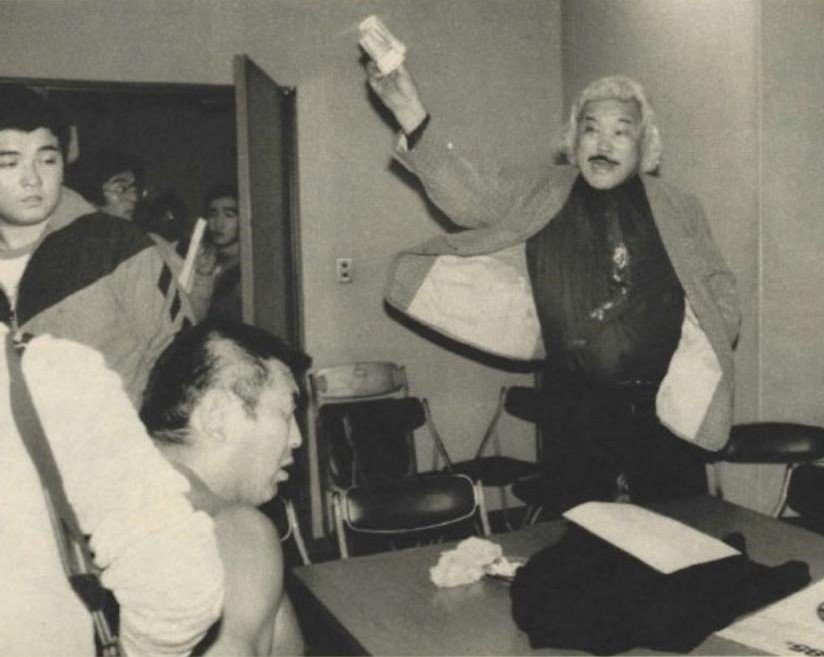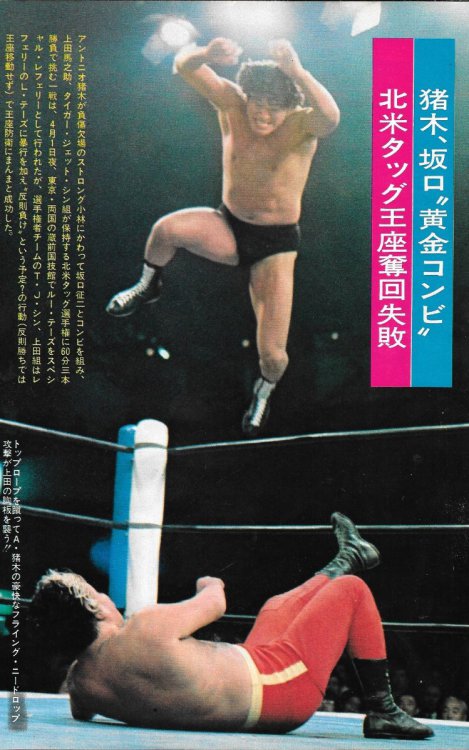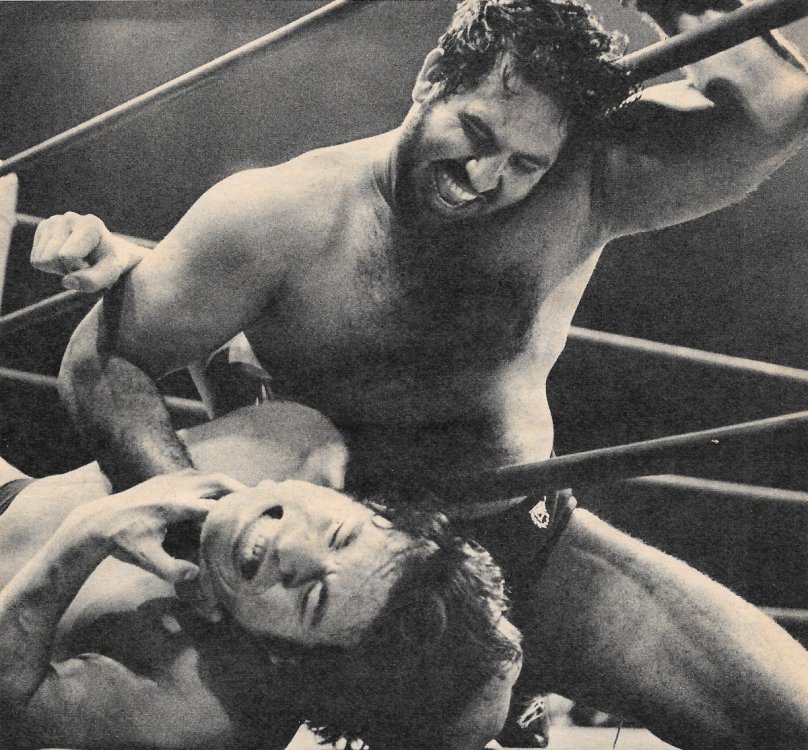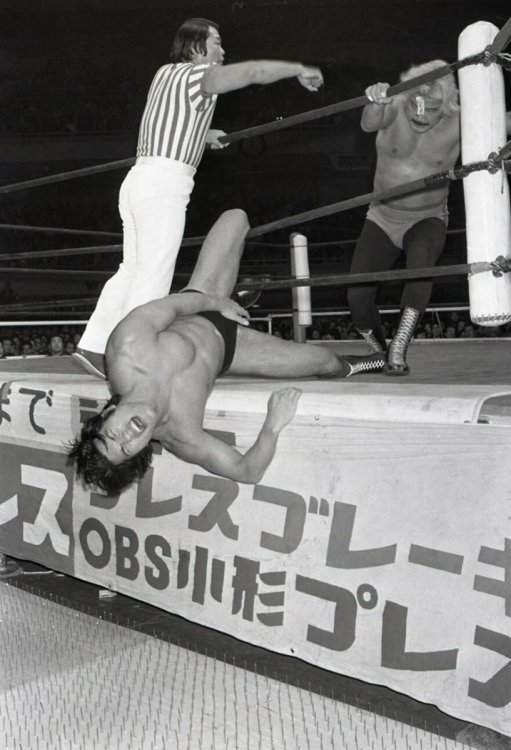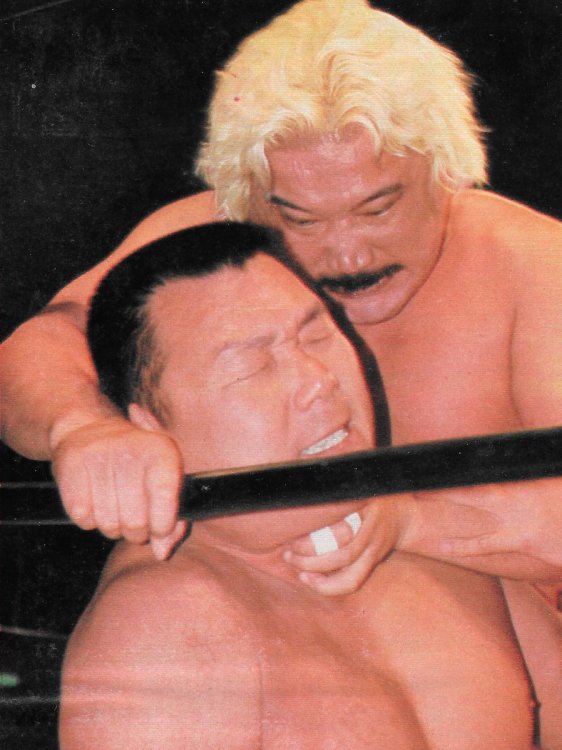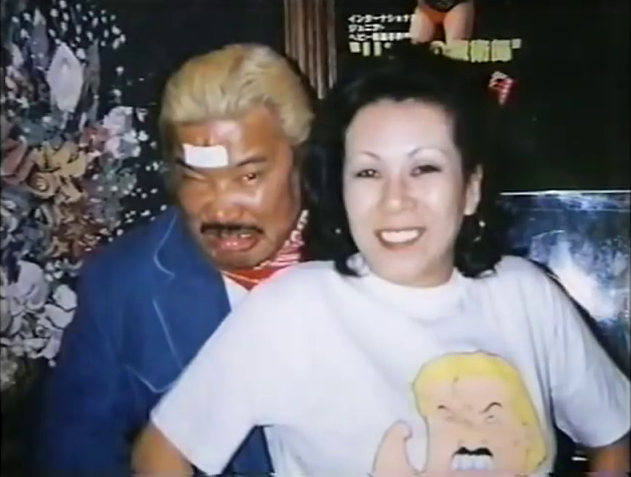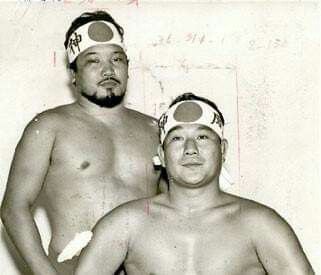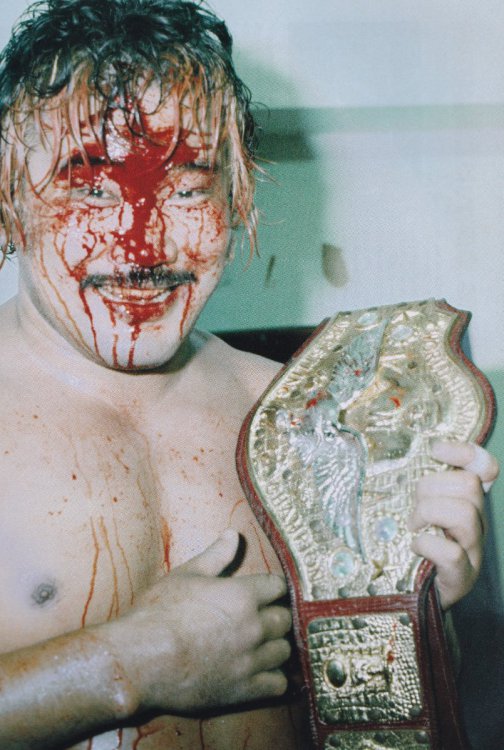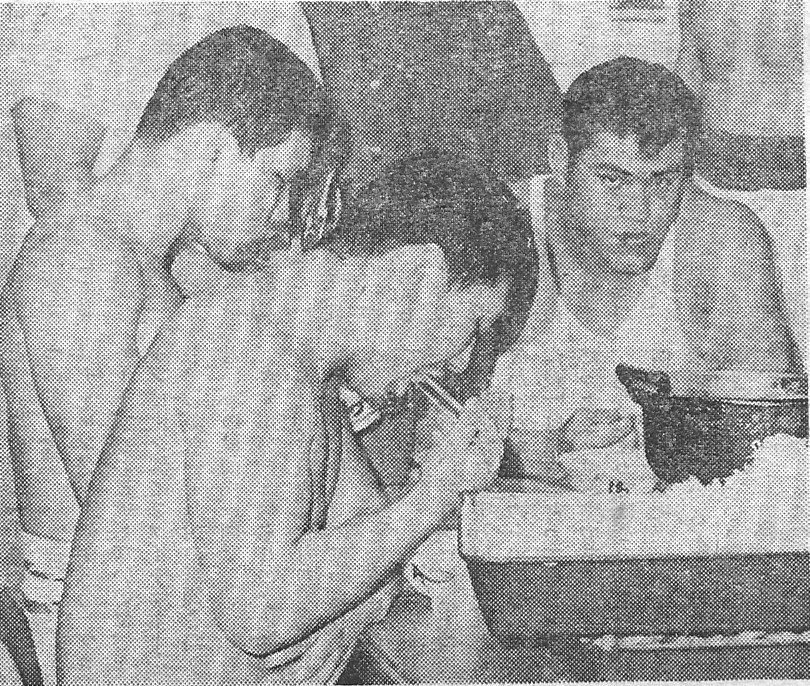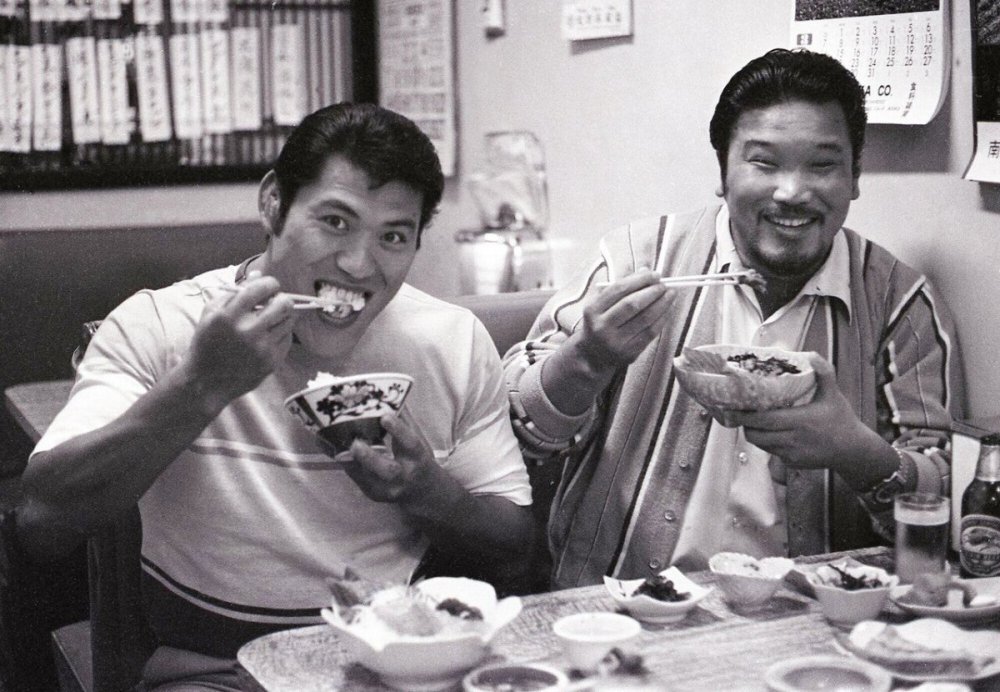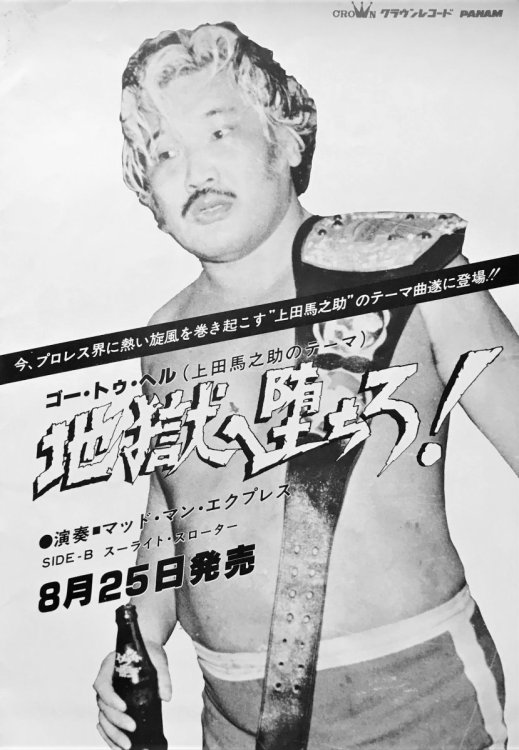-
Posts
422 -
Joined
-
Last visited
Content Type
Profiles
Forums
Blogs
Everything posted by KinchStalker
-
I am four thousand words into a Deluxe Profile on Killer Khan, which will essentially adapt his 2018 autobiography. Just about finished with his JWA tenure.
-
UPDATES, DECEMBER 2023 My last profile of the year was the longest I have yet written: a 16,000-word behemoth on puroresu's first great worker. Michiaki Yoshimura (Wrestler/Executive/Booker, AJPWA/JWA) [DELUXE PROFILE #3] ------ For 2024, I plan to write a profile for the recently departed Killer Khan, with his autobiography as a primary source. I also have the autobiography of the Great Kabuki and would like to give him similar treatment. Another profile I have planned is for Umeyuki Kiyomigawa. Excluding Rikidozan, who I am far from ready to write a profile for, and Masahiko Kimura, who I am arguably unqualified to write about, Kiyomigawa is the most notable figure of early mens' puroresu that I have not yet written about.
-
I just got an ebook of Khan's autobiography for cheap. I can't promise a quick turnaround but I'm going to give him a profile on here.
-
Someone I follow on Xitter pointed out all of this stuff leading up to Fyter Fest 2019. It's all speculation at this point, but I haven't been able to stop thinking about it.
-
RIP. Plugging the 1979 article that I translated last year, about his brother's ill-fated wrestling career and how that inspired Osamu to finish what he had started.
-
PART FOUR: FIGHTING GENERAL (1967-1973) Yoshimura was a double champion for over half of 1967. On the year’s first tour, he defended the All Asia titles twice against teams centered on the aging Mr. Atomic, while he and Baba went to a broadway with Atomic and Buddy Austin. The following MSG Series is most famous for Baba’s pair of draws against close friend Bruno Sammartino, but Baba & Yoshimura also defended against Austin & Hans Schmidt on that tour. Underneath the second of Baba & Sammartino’s matches, Yoshimura & Oki wrestled the same opponents in a non-title match. Besides the very final Yoshimura match in circulation, this is the only surviving match of his team with Oki. The 9th World League pushed the returning Destroyer and Waldo von Erich as its foreign favorites. As Oki left the tour after only working three of his tournament matches, plus what would be a final tag defense in Osaka, Yoshimura placed second among the natives. He and Baba were neck-and-neck right up until the tour had nearly ended, when he lost against Waldo. Baba went on to beat the Destroyer in Yokohama. In retrospect, all this is overshadowed by the return of Antonio Inoki, which was announced on April 7. Inoki and most of Tokyo Pro had worked on the first tour of Yoshiwara’s new promotion, but quickly fell out with them. Through the mediation of Daily Sports reporter Masakiyo Ishikawa, Inoki had gotten an interview with Baba, which led him to negotiations with Yoshinosato. Inoki made the company agree to eight conditions for his return; this document has never been publicly released, but it is known that these conditions related to his salary and booking.2 Inoki was set to return to the ring on the following tour. With the help of his biggest money mark, South Korean president Park Chung-hee, Oki had booked a title match against WWA Heavyweight champion Mark Lewin. On April 29, he beat Lewin in Seoul.1 Most records state that the All Asia titles were vacated that month after Oki suffered a car accident. In truth, this car accident was a fictitious attempt on Oki’s part to get out of defending his new title in Los Angeles. After the WWA threatened to strip the title, he ended up going to their territory after all, and would be overseas for an All Asia defense which had already been booked as part of a two-night run in Sapporo. Oki was fine with that title being vacated, and had suggested that Yoshimura team up with Umanosuke Ueda, then working as Great Ito. What Oki did not want was for Yoshimura to team up with Inoki. Guess which of these happened. Three days after Baba & Yoshimura defended the International tag titles against Waldo & Fritz von Erich in Osaka, Inoki was slotted in for the All Asia match against Waldo & Ike Eakins. He and Yoshimura were attacked before their entrance had finished, and the bell rang as they brawled around the arena, at first still in their gowns. With the help of a chair, Inoki got enough time to finally enter the ring, but Waldo brought out a foreign object and hit both men. Oki Shikina ruled the first fall as a DQ, in just under six minutes. The second fall began with another scuffle by the announce table, before Inoki & Yoshimura rolled back into the ring. Once in the ring, Yoshimura dropkicked Waldo off the apron and tagged in Inoki, who took it to Waldo, and then Eakins, with his signature “knuckle arrow” punches. Back between the ropes, Inoki got Eakins in the cobra twist, but Waldo broke it with a punch. As Inoki tagged out to introduce Waldo to the ring post, Yoshimura laid Eakins out with a dropkick for the win at 13:18. Yoshimura was a double champ again, and he remained so throughout summer 1967. It was a notable summer for the JWA, if not for him in particular. In response to the IWE’s second tour, they booked NWA champion Gene Kiniski to challenge for Baba’s International Heavyweight title, running that match in the mortar bowl-shaped Osaka Stadium opposite the IWE’s show at the Prefectural Gymnasium. That fall, the plan was put in motion for Yoshimura to step back, and for Baba & Inoki to team up. On October 6 in Fukushima, Baba & Yoshimura dropped the International tag titles to Bill Watts & Tarzan Tyler. Yoshimura took a week off to sell a cracked rib from Watts’ Oklahoma Stampede. When Baba & Inoki won the titles back on October 6, the B-I era began, and Inoki vacated the All Asia titles. On January 6, 1968, Yoshimura and Oki revived their All Asia duo when they beat Bill Miller & Ricky Hunter for the belts. That was the first of a two-night stint in Osaka, after which the boys flew to Hiroshima for a Hiroshima show on the 8th. Inoki took a flight back to Tokyo due to an issue with his common-law wife, Diana, and planned to fly back in time for the show.3 Alas, his flight back was canceled due to a snowstorm. A tag title defense had been scheduled that night, so Baba & Yoshimura reunited to challenge Miller & Crusher Lisowski. The match went to a double countout in the third fall to keep the belts held up. When the tour ended in Tokyo, Baba & Inoki went over that team to win them back. In the meantime, Oki turned in his resignation on January 17, and then attempted to jump ship to the IWE, then under its short-lived rebrand as TBS Pro Wrestling. He flew to Sendai for their show that night, but was threatened not to show up, and quickly reinstated.4 He and Yoshimura mounted another All Asia defense near the end of the tour. The next tour kicked off at Korakuen Hall on February 16, but there was a major problem: the six foreigners set to fly in had been snowed out of Haneda Airport. That night, the JWA held a six-match card of native vs native matches. In the main event, with Inoki sitting in as referee, Baba beat Yoshimura with a backslide in 15:36. It was Yoshimura’s last match against one of the three stars he had fought off so many times in the early sixties. That tour, the Dynamite Series, marked the start of Mitsubishi Diamond Hour’s exclusive residence at the Friday 8PM timeslot, which was a response to the IWE’s new weekly broadcasts. (Disney was moved to another night.) Notably, it also saw the Japanese debuts of Harley Race and Dick Murdoch. In an interview with Koji Miyamoto shortly before his death, Race remarked that Yoshimura was the best wrestler in the company, as he was “several steps ahead” of Baba and Inoki when it came to carrying a match, and Race could say “with confidence” that he never had a bad one with him. Koizumi makes an interesting point. The singles matches that Yoshimura had wrestled against younger talent, holding the line to the upper card, had ceased after Rikidozan’s death. However, Koizumi believes that Yoshimura fulfilled this role for foreigners in his later career, guiding young and hungry B-class players with a solid hand. Koizumi also regards this period as a high point for Yoshimura as a booker, such as his push of Buster Lloyd (Rufus R. Jones) in early 1969. That saw Lloyd go over Oki in a buildup singles match, where Oki’s head was still bandaged from an infamous ear-cutting incident the previous year in Sendai, and he was unable to use his headbutt.5 When the JWA ran Sendai again, Lloyd and Oki squared off in a defense of Oki’s Asia Heavyweight title. Yoshimura & Oki kept the All Asia titles for most of 1968, with only a three-week loss in July to put over Skull Murphy & Klondike Bill. Yoshimura’s last match in Korea was a defense that November against Buddy Austin & Red Bastien. Like their first, their third reign was vacated, but it was not Oki who would be unavailable. Yoshimura left for the United States in January 1969, and Oki teamed up with Inoki to win the titles instead. After the IWE’s relationship with booker Great Togo had soured the previous year, Togo had a plan to form his own Japanese promotion with the supposed backing of Lou Thesz. Kokichi Endo started negotiations for a second television program with the NET TV network, which was prepared to work with Togo if the deal fell through. Yoshimura’s job, evidently, was to prevent Togo from trying what he had with Oki the previous year. As Koizumi concludes, Michiaki worked a scattered series of dates across the United States primarily to meet with and secure the loyalties of overseas talent that were working in those territories, but also to book some gaikokujin. Yoshimura started with a match in Los Angeles against Harley Race on January 23. Three weeks later, he was in Detroit. Great Kojika was working for Ed Farhat at the time, so Yoshimura teamed up with him and Duke Keomuka on February 15. After that, Yoshimura and Keomuka went down to Fritz von Erich’s territory, where Yoshimura worked a week of dates while negotiating for Fritz’s return to Japan. He then followed Keomuka to Florida, where he met with Seiji Sakaguchi. The two wrestled as a team in West Palm Beach, and then, in Yoshimura’s final match in the US, in Los Angeles. Finally, on March 18, he and Sakaguchi returned to Japan. The 11th World League was booked with the knowledge that the JWA had a new TV program coming in July. Nippon Television laid out several conditions for their approval of another network deal, the most important of which was their exclusive rights to Baba. The program, which was to be called World Pro Wrestling, called for the JWA to develop a parallel ace. The result may have been one of Yoshimura’s greatest achievements as a booker, but he could not quite claim full credit. The World League began at Tokyo’s Kuramae Kokugikan after a warmup show in Korakuen. On the Kuramae show, Sakaguchi made his Japanese debut alongside Yoshimura in a tag against Medicos #2 & #3 (Luis Fernandez & Tony Gonzales); Koizumi speculates that Yoshimura, and possibly the Medicos as well, had given Sakaguchi further coaching in Los Angeles. Yoshimura had booked himself to a middling result the previous year but made something of a resurgence. His six points tied with Oki and edged out Sakaguchi, whose name value drew tickets but whose skills were found somewhat lacking by the higher-ups; he was sent back overseas after the tour. Gorilla Monsoon started strong, beating Baba in the first match of the tournament, but double countouts against Oki and Sakaguchi, and a loss to Inoki, set him further behind; a massive upset against Kotetsu Yamamoto followed in early May. Yoshimura himself went over finalist Bobo Brazil in a later match. At the end of the tournament, both the native and foreign sides had ties. Baba, Inoki, Brazil, and the debuting Chris Markoff – who Yoshimura had scouted while overseas, alongside Bobby Duncum – all had 6.5 points. On May 16, at the Tokyo Metropolitan Gymnasium, a coin flip decided which native would wrestle which foreigner; it was made clear that if a tie remained after these two decision matches, a further decision match would take place regardless of sides. After Baba and Brazil dragged each other out to a half-hour draw, Inoki debuted the octopus stretch he had previously demonstrated to win the World League. Alongside Endo, referee Yusuf Turk had lobbied for Inoki to win the tournament, and as he confirmed to Koizumi near the end of his life, it was he, and not Yoshimura, who booked Inoki’s final match against Markoff. Inoki & Oki had won the All Asia titles from Buster Lloyd & Tom Jones in February, but they vacated the belts after just two defenses. This was partially so that Oki could defend his singles title on the same show as an All Asia defense, but according to Koizumi, it was also because the two just did not mesh well as a unit. So it happened that puroresu’s greatest supporting wrestler booked himself for a second run with Inoki. In fact, when World Pro Wrestling premiered on July 22, its first episode (from the June 23 show in Ota) featured an Oki singles match (against Eric von Stroheim), and an Inoki-Yoshimura tag against the Steiger brothers. On August 9 in Nagoya, Inoki & Yoshimura beat Crusher Lisowski & Art Michalik. The major roadblock came that fall, when they fought Mr. Atomic & Buddy Austin in a trio of defenses. In Osaka on September 27, the heels bloodied Yoshimura with a weapon and won the first fall with an Atomic neckbreaker, but a cobra twist from Inoki and a Yoshimura rolling clutch won the day. On October 10 in Yamagata, Atomic had Yoshimura in another neckbreaker in the final fall, but Inoki reached out and grabbed Yoshimura’s forearm to keep him standing. After the challengers complained about the pinfall that resulted, the belts were actually held up for a final match in Yoshimura’s hometown. On October 30, the champions won them back. If one discounts his three years with a junior heavyweight championship that he only defended for less than one, this third run with Inoki was to be the longest title reign of Michiaki’s career. Gene Kiniski, Harley Race, Johnny Valentine, and the Assassins were just a few of the challengers that they fought off. The 12th World League was a step down from the heights of the previous year and reverted to a Baba victory. Baba could not put Don Leo Jonathan away clean in the final, as he hit himself in the groin on the ropes with a missed dropkick. (Inoki got a pinfall on Jonathan in the tournament itself but had choked in a Markoff rematch.) The problem was not just with the booking, though. With two television programs arguably oversaturating the product, not to mention the coverage of the six-month Expo ‘70 world fair, Koizumi claims there was a dip in attendance, one which Sakaguchi’s return did little to help. From the start of the World League, World Pro Wrestling changed from a taped show at 9PM on Wednesdays, to a live broadcast at 8PM on Mondays. This switch only caused further headaches for the booker. On taping dates, Yoshimura was now forced to slot Baba in the midcard so that his match was finished before cameras started rolling. Anyone would struggle to book a good show under such conditions. As for the man himself, Yoshimura suffered a legitimate rib injury during a tournament match against Tarzan Tyler. After this, the 43-year-old lightened his schedule to wrestle less than half of the JWA’s shows. He moonlighted as a color commentator on World Pro Wrestling, a seat that Endo and Yoshinosato also filled. Yoshimura can be heard calling Inoki’s classic match against Jack Brisco from August 1971. Yoshimura and Sakaguchi at the River Thames, near the Tower Bridge. Yoshimura wrestled his last match abroad in summer 1970, when he and Sakaguchi traveled to London to work a show for Dale Martin. Koizumi claims that this came about because ITV wanted to “introduce Japan” on the television program World of Sport. It is also worth noting that it was Martin who had approached the JWA, and not Leeds-based promoter George de Relwyskow, who had booked British talent for the IWE in the late sixties. It is very likely that the pair were scouting for a wrestler worth promoting as a foreign rival for Sakaguchi. In Croydon on July 21, Seiji beat Pat Roach, soon to shoot his film debut in A Clockwork Orange, in a round match. Yoshimura, for his part, won against Hans Steiger by disqualification. Sakaguchi left for a third excursion in September. That was when the JWA began its first NWA Tag Team League. NET wanted a tournament which would parallel the World League while spotlighting Inoki. The only problem with this was that the company’s most popular tag team was one that literally could not appear on World Pro Wrestling. Baba and Inoki were thus paired with midcarders Mitsu Hirai and Kantaro Hoshino, while Yoshimura teamed up with his former valet Great Kojika. The following year's second league was an improvement over the tournament’s maiden voyage, at least in conception. The experiment of pairing top stars with midcarders was abandoned in favor of a pair of clear favorites. While Inoki and the returning Sakaguchi gave a first glimpse of NJPW’s future Golden Team, Baba revived his double-champion duo with Yoshimura. Where that tour faltered was in the challengers. On the second tour of 1971, the JWA booked two wrestlers who had topped an IWE fan poll the previous spring: Spiros Arion and Mil Mascaras. As Yoshimura had scaled back his appearances by this point, he would not have a singles match with Mascaras until the following summer, when the luchador made his final JWA appearances. But he left an impression. At the start of 1978, Mascaras won the Best Bout Award from Tokyo Sports for the 1977 “Idol Showdown” against Jumbo Tsuruta. He proceeded to admit privately to Tsutomu Shimizu that Jumbo was still green compared to Yoshimura, who he wished he could have worked with in his prime. For the 13th World League, NTV lifted one of their original restrictions and allowed World Pro Wrestling to broadcast matches from the tournament. This iteration, and the final one which followed in 1972, changed the format. Double countouts no longer awarded half a point to both men, but more importantly, there would now be a double round-robin. Just a few days into the tour, at an April 7 show in Osaka, Inoki complained to the press that the booking was unfair; he had been forced to wrestle three League matches on consecutive shows, two of which were against star gaikokujin Abdullah the Butcher and the Destroyer, before Baba had even wrestled one. Yoshimura was reportedly furious when these remarks saw print. That booking would repeat the four-way tie of the 11th, only with the Butcher and the Destroyer as the top foreigners. On May 19 in Tokyo, Inoki and the latter wrestled first and went to a double countout. As Baba wrestled the Butcher, Inoki blindsided everyone with a backstage press conference where he went into business for himself and challenged Baba for his NWA International title. This proposal was obviously rejected, but Inoki’s refusal to retract his challenge got him over with younger fans at Baba’s expense. In fact, Yoshimura had to convince Baba to work with Inoki in a tag title defense that June. As he later recalled, by the end of the World League the locker room had clearly split into two factions supporting Baba and Inoki. As I have covered elsewhere, that all culminated in the "phantom coup" of late 1971. Much of the third part of Koizumi’s Yoshimura feature is actually devoted to Etsuji’s own theory about the “phantom coup”, which is that the accusations of managerial corruption which they hinged on were exaggerated, and that the “corporate reform” which Inoki had supposedly turned into a takeover attempt had always held that goal in mind. He believes that the official narrative of the phantom coup underplayed the role of the co-conspirators who remained with the JWA: namely, Baba and Umanosuke Ueda. Koizumi’s hypothesis hinges on a recent testimonial from Baba's valet at the time, Akio Sato, which revealed that Baba and Ueda had conducted their own investigation of the JWA's finances that summer. The theory is compelling, and it has vindicated some doubts that I have always had about the story and the discrepancies between various testimonies. To go into it would take us too far off track, but I will address one thing. The extent of Yoshimura’s corruption, as was alleged, was that he paid off reporters who covered JWA shows. Koizumi believes it is far more likely that someone wanted to take over as booker, and his best guess is Kotetsu Yamamoto. Koizumi also recounts an interesting story from before the coup, but after Yoshimura had scaled back his in-ring work. He still attended every show because it was his job to collect the money from promoters. One day, though, he was not given a train ticket, and when he went to announcer Nagaaki Shinohara, whose job it was to buy tickets, he was told that the order came from above him, but Yoshinosato knew nothing about it. Koizumi speculates that this was Baba’s attempt to take the collector job for himself.6 Now, this theory should be weighed against testimonies that Baba and Yoshimura had a strong relationship. Yoshimura's final valet, Masashi Ozawa (the future Killer Khan), recalled that the two liked to play mahjong on Yoshimura's off days. Many years later, Baba told Masanobu Fuchi that, alongside Naoki Otsuka, Yoshimura was one of only two honest executives that he had ever worked with in puroresu. Whatever the case, though, Yoshimura relinquished neither duty. Yoshimura and Sakaguchi train at the beach, c. July 1972. After Baba & Inoki dropped the NWA International Tag Team titles to the Funks on December 7, Inoki booked it out of the Sapporo Nakajima Sports Center and checked himself into a surgery clinic for his own protection. Many were glad to be rid of him, but his absence created a new issue for Yoshimura. Inoki had been booked to challenge Dory Funk Jr. for the NWA title just two days later, and at the end of the tour, to defend the All Asia titles with Michiaki against Dory & Dick Murdoch. The following night in Osaka, Sakaguchi learned that he would be filling in for Inoki in both matches. The first was a rock-solid traveling champion’s bout. The second, in Koizumi’s estimation, was Yoshimura’s last great match, and as much a triumph on his part as his match with Karl Gotch a decade before. Years later, Murdoch gave a backhanded compliment to a man whose name he could not recall: one who, as Koizumi roughly translates, “was mostly a piece of shit, but had a lot of guts.” For the 14th and final World League, Yoshimura penciled himself to only gain eight points. That tournament, which Baba won to notch a second three-year streak, is far more notable now for what was going on behind the scenes. World Pro Wrestling ratings had plummeted to the 3% range after Inoki’s dismissal, so they forced the JWA to let them broadcast Baba’s matches. After the final, in which Baba beat Gorilla Monsoon, NTV canceled Mitsubishi Diamond Hour in retaliation, and sent feelers to Baba for a new venture. That summer, Baba announced that he would depart the company at the tour’s end. NET had insisted that Sakaguchi and Oki were not enough to sell their show on; now thanks to them, the JWA had no one else. The JWA had already booked its tour circuit for the year by the time he left, but without Baba, the promotion could only survive as long as network money funneled through. The returning Akihisa Takachiho and Gantetsu Matsuoka were given pushes, the former as Sakaguchi’s tag league partner, the latter as a challenger to fellow apple-crusher Danny Hodge. But Koizumi believes that Yoshimura was burnt out by this time. As evidence, he cites how Bobo Brazil was booked on the last tour of 1972 as Oki’s challenger for the vacant NWA International title. Oki lost the first match after a weapon attack in the second fall, as after Bobo pinned him, he rolled out of the ring and was counted out for the third. Three days later in Hiroshima, Oki struck Bobo in the throat with a foreign object. Oki had gotten a win over an icon like Bobo, but he needed a better win than that. Koizumi speculates that Brazil had already made his booking with All Japan the following February but made himself open for business under the condition that he would be protected. Yoshimura never would have accepted such a deal before, but the JWA was in a bad way, and he probably did not care much. In January 1973, Yoshimura announced his retirement. Kojika and Ushinosuke Hayashi begged Yoshimura to stay on board, but he would not be swayed. Michiaki could no longer cope with his back pain and had already arranged to move to Kobe. As he admitted in his press conference, this had been a long time coming. He had seriously considered it as far back as 1970, after the World League injury. A timeline provided in Konjo reveals that Michiaki's brother, Yoshimatsu, died in 1971; it's certainly plausible that this may have prompted some reflection. Yoshimura was too important to the company to quit after the fallout of the phantom coup, yet he had reached his limit. After one final defense on January 28, which he and Sakaguchi won against Billy Red Lyons & Mr. X (Jim Osbourne), the pair vacated the All Asia titles. Yoshimura wrestled just one more match after that. On March 3, at Kinki University’s Memorial Hall, Yoshimura defeated Ruben Juarez before Kojika & Matsuoka were set to challenge for his vacated belts. The band played his favorite song, which he had first heard during his Toyota years: the wartime ballad “Rabaul Kouta”. Yoshimura returned to Kinki’s sumo club as an advisor but quit around 1974 after losing a match to a freshman, the future Asashio Taro IV. According to Ozawa, he made his love of mahjong into his business, opening a parlor in Osaka. It has been reported that Yoshimura had some involvement in Big Japan Pro Wrestling, an organization which Yusuf Turk attempted to form in the late seventies. Outside of that, though, he stayed out of pro wrestling until the mid-nineties, when he helped out his old kohai Kojika and his own nascent BJW by introducing him to sponsors. Yoshimura got back into the business through the Rikidozan OB Association, a group of JWA alumni that promoted a few shows in the late nineties. He made a handful of appearances in this period, such as at New Japan’s 1998 Inoki the Final show. After Junzo Hasegawa’s death, Yoshimura replaced him as chairman of the Association, which held its final show in 2000. In the summer of 2001, Yoshimura served as a guest coach for his alma mater’s sumo club. That, as far as I could find, was the last notable incident of his life. On February 15, 2003, Michiaki Yoshimura died of respiratory failure. “He was a tasteful wrestler. Although he had a reputation as a technician, he was by no means a skillful person. In fact, I feel like he overcame his clumsiness with effort and perseverance to maintain his value as a technician. He wasn't very good with dropkicks, and his only footwork was an [Indian] deathlock. He didn't have a finishing hold or anything else to look at other than a rolling clutch hold. However, his guts were amazing. He also had a strong personality, going head-on and accepting any technique his opponent tried, which may have been what made him popular with Japanese fans. [...] He taught me two things: patience and fighting spirit.” - Antonio Inoki, 1990 Yoshimura and Tatsumi Fujinami at the June 30, 1996 Rikidozan Memorial Show. FOOTNOTES
-
PART THREE: FIREBALL BOY (1960-1966) Yoshimura and Toyonobori spent six months working weekly Honolulu dates for Mid-Pacific Promotions. The pair returned in time for the 2nd World League. This time, Yoshimura joined Rikidozan, Toyonobori, and Endo as the fourth Japanese contestant, and as a suitable foil for former NWA junior champ Sonny Myers. The tour began with a three-night run at the Tokyo Metropolitan Gymnasium, and Yoshimura lost both of his tournament matches on those shows, first against Dan Miller and then against Myers (see some footage of the latter here). On the third night, he and Rikidozan teamed up for the first time against Myers and tournament favorite Leo Nomellini. The first fall saw Michiaki get his win back against Myers, but the match would be remembered for the third fall, when Yoshimura took a Nomellini tackle off the apron. Selling two cracked ribs, he was counted out, then taken by stretcher to the waiting room. He missed the next show before returning to the tournament, and excluding a draw against Stan Lisowski, he won all his other World League matches. As Koizumi points out, though, just those first few matches had already shown what Yoshimura would have to offer in matches against gaikokujin. As the best worker of puroresu’s first generation, he was capable of technical matches against the second tier of a given tour’s slate of foreigners; the subsequent tour saw multiple Myers rematches, a couple of which went to 45-minute draws. On the other hand, Yoshimura was the best whipping boy to put over a tour’s top baddie and sell their killshot with a worked injury. The latter tendency earned him the nickname that provides the title for this part of the bio, “Hinotama Kozō”; the fireball was a tribute to the fierceness with which he fought whilst busted open. The next tour retained some of the World League’s foreigners for another smaller tournament, the World Selection Series. On June 2 in Osaka, the All Asia Tag Team title—which was originally a trophy—were revived after five years. The champions were set to be determined in a one-night tournament between four teams: Rikidozan & Yoshimura, Toyonobori & Endo, Myers & the Great Togo, and Dan Miller & Frank Valois. Yoshimura pinned Myers to advance to the finals against Miller & Valois. Yoshimura lost the first fall to a Valois piledriver, but evened things against Frank with a piledriver in short order. Despite the interference of Myers & Togo, the latter of whom threw salt in Yoshimura’s eye, the match result stood as Yoshimura’s loss by countout. Rikidozan successfully appealed to the commissioner to keep the title vacant until a match five days later in Nagoya. There, though, Rikidozan teamed up with Toyonobori, and the pair won the titles. Yoshimura would fill in for Toyonobori on subsequent occasions over the next few years, and although it is commonly presumed that Toyonobori’s supposed injuries were fictitious coverups for his disappearing acts to evade debt collectors, it was he who remained favored by Rikidozan. Yoshimura never totally shook off his status as an outsider. On August 19 at Tokyo’s Taito Ward Gymnasium, the Japan Junior Heavyweight title was thawed for a final defense to mark Yoshimura’s promotion to the heavyweight division. If one excludes TV tapings, this was the first singles main event of Yoshimura’s career. In a match refereed by his boss, Michiaki went the full 61-minute Hawaiian Broadway with Yoshinosato. The champion struck first with a headscissors, and a lively exchange followed for the first five minutes. Yoshinosato was physically inferior, but he was scrappy, and he wore Michiaki down with fouls as the match progressed. Yoshimura won the first fall in 28 minutes with a half crab, but the challenger got a pinfall in 37:35. Yoshimura’s second wind petered out in the last ten minutes, and the grueling match went to a draw. Yoshimura, Sachiko, and their daughter Kiyoko in the early sixties. Yoshimura left for a second Hawaiian excursion in December, by promoter’s demand. Sadly, he missed the birth of his daughter the following month. On January 11, he took part in a one-night tournament for the number-one contendership to the Hawaii Heavyweight title, and beat Lou Newmann in the quarterfinal, but then lost to former NWA world champion Dick Hutton. Hutton went to a draw in the final against Sam Steamboat, after which the contender was decided by a coin flip. Hutton beat Al Lolotai to win the title on January 18, only for Steamboat to beat him to begin a four-month reign. Yoshimura claimed in Konjo that Hutton made a great impression on him, and that he had personally requested a match with him to promoter Al Karasick. During this excursion, he finally mastered a move that he had previously seen from Lord Blears, and which he claimed Blears encouraged him to adopt. That move came to be known in Japan as the rolling (back) clutch hold, or kaitenebigatame, but you know it as the sunset flip. On February 1, Yoshimura got a title shot against Steamboat and went to a 45-minute draw; according to him, the one fall he scored was with the rolling clutch. Koizumi also believes that Yoshimura could have been inspired by seeing Eduoard Carpentier work in Hawaii. He returned to Japan at the end of April, to meet his daughter Kiyoko and to enter the 3rd World League. The tour kicked off on the first of the month, with the most famous match of Yoshimura’s career. “And then the first match I had was in Tokyo Palace. I saw the guy. He was a college sumo champion and he was pretty good worker, too. We worked there. But the way I worked over there was they asked me. They said, "Can you go through with him?" I said, "Sure. Why not?" Because he thought nothing of me. He thought I was a small guy. So, by the time the match was over, I got a standing ovation. They never saw that before in Japan.” - Karl Gotch in conversation with Jake Shannon, October 2004 Karl Krauser, the man who would be Gotch, was an Olympian wrestler with a decade in the business, and a background in catch-as-catch-can through the training of Billy Riley. Unlike the first two iterations of the tournament, in which all but the final match were contested in three eight-minute rounds, this year’s matches were three-fall, 45-minute affairs, and the pair used all of that canvas. Krauser won the first fall with the first German suplex ever performed in a Japanese ring, and Yoshimura won his own fall with a backslide, before the two went to a stalemate. Koizumi believes that this is one of the most important matches in puroresu history, and one sees his point. For his part, Yoshimura called it the best match of his career, and considered it a personal breakthrough. Even in its cruelly abbreviated form, this match is one of the most valuable pieces of wrestling footage in the 1960s. In a display of his versatility, Yoshimura put over Jim Wright the following night in a bloody brawl. He wrestled Krauser four more times on this and the subsequent tour. First, Karl won a League rematch on May 13. On July 2, Yoshimura forfeited the third round of an Ibaraki outdoor show, but the match was deemed a no-contest at Krauser’s request. Finally, at an elementary school in Fujiyoshida on July 22, Yoshimura won a 2/3-falls match. It was the only time that Gotch lost two falls clean to a Japanese wrestler. Another draw followed in Sawara two days later. Yoshimura wrestles Kanji Inoki in August 1962. 1961 also saw Yoshimura try on a new hat. According to Dave Meltzer’s obituary, Rikidozan regarded a match with Michiaki as the ultimate aptitude test for a young wrestler. That June, Shohei Baba’s last match before leaving for the States was a loss to Yoshimura. In July, Kintaro Oki stepped up to face him in Asahikawa. Finally, on May 13, 1962, Kanji Inoki suffered his first loss to Yoshimura. From that first Baba match through the end of 1963, the “three crows” of the Riki Dojo wrestled a total of over fifty singles matches with Yoshimura. As each man grew in experience, their matches were occasionally expanded to 2/3 falls, and even given the semi-main time limit of 45 minutes. Mammoth Suzuki, Mitsuaki Hirai, Umanosuke Ueda, and Gantetsu Matsuoka also had singles matches with Yoshimura in this period. Two weeks after the Riki Sports Palace opened, the JWA held their first show at the Roppongi venue on August 13. In the main event, Yoshimura teamed up with Rikidozan and Toyonobori to face the Zebra Kid, Aldo Bogni, and Don Manoukian. Bloodied in a foul that ended the first fall, his wound was exploited by the Zebra Kid’s assault, and by the third fall, Yoshimura was unable to continue. Oki Shikina overturned the match as a DQ win for the natives, while Yoshimura begged for a chance to get even. The JWA’s next scheduled main event was Riki & Toyonobori vs. Zebra & Manoukian, and after Toyonobori was written out with a supposed wrist injury, Endo was initially penciled in as his replacement. Yoshimura filled in for Endo as Riki’s partner and got that shot against Zebra & Manoukian. Zebra busted him open with a wooden chair from the press box, and was put down for the first pinfall by a bodyslam and tackle. The heels booked it out of the arena in the second fall, to escape their comeuppance from a furious Rikidozan. Mitsubishi Diamond Hour expanded to a weekly program. It still alternated the 8:00pm timeslot with Disneyland, but aired at 10 on those weeks. At a TV taping in December, Yoshimura put over Luther Lindsay in a big way, selling his backdrop at 7:29 as a concussion-inducing knockout, and allowing Luther to win two falls with one move. In 1962’s 4th World League, which reverted to the original three-round system, Yoshimura wrestled the likes of Lou Thesz and Freddie Blassie. He also received three matches with Dick Hutton, and while he lost the League match, he won their last encounter, which took place on Hutton’s last date. Koizumi speculates that the former NWA champion put Yoshimura over as a gesture of respect. In 2018, fellow entrant Larry Hennig told Koji Miyamoto that Yoshimura had impressed him most among the Japanese. At the start of the autumn tour, Rikidozan had suffered a legitimate shoulder injury against Moose Cholak but was forced by show promoters to return to the ring after just four days. He got through by borrowing his son Yoshihiro’s football pads, and the tour became a waiting game for when he would remove them. Just days before a scheduled tag defense, Toyonobori injured his leg on a house show in Hakodate; as he was present for the defense in question, this injury was apparently legitimate. As the story went, commissioner Raisuke Kudo persuaded the challengers over beer and a grilled mutton hot pot to accept a match with Yoshimura as a substitution. Unbeknownst to Murphy and Marconi, Riki had healed, and when Murphy made a crack about whether Riki was looking to play football, the ace threw the pads into the crowd. Murphy bloodied Yoshimura with an empty can in the first fall, which the natives won by DQ when Cholak and Art Mahalik interfered, but Skull took a Yoshimura pin for the second fall. In early 1963, Toyonobori disappeared again for a supposed knee injury. Kudo offered to have Yoshimura substitute for Toyo again on the January 29 defense against Jess Ortega and Tony Marino. This time, Riki instead opted to vacate the tag titles first. In this match, as well as a March 4 rematch, the Japanese team won, but did not score two falls either time, so the belts were held up until Toyo returned in May. In the 5th World League, the first with an equal slate of Japanese contestants (if you count Rikidozan, who did not wrestle in the League seed itself), Yoshimura got one clean win against Sandor Szabo, and half-points for countouts and fouls against Fred Atkins, Bob Ellis, and Gino Marella. This tour is more remarkable for Yoshimura in that there is surviving footage of four matches from this tour: tournament matches against Pat O’Connor and Killer Kowalski, and a pair of tag matches. On the last day of May, Yoshimura beat the future Gorilla Monsoon in the main event of a televised benefit show for the Tokyo Olympics. At some point during the year, Yoshimura also invited former AJPWA coworker Kanji Higuchi, who had retired from the JWA in 1960, to return in a backstage capacity and look after gaikokujin.1 On November 22, 1963—incidentally, the date of JFK’s assassination—Yoshimura was taken out by Rikidozan’s own chop. This is notable because, while such friendly-fire finishes would continue to show up in the JWA, they never happened on the native side. Two weeks later, Yoshimura teamed up with Rikidozan on the last show of the tour, in a six-man tag in Hamamatsu which went to a full broadway. The following night, his boss was stabbed in a nightclub. Before Rikidozan’s public funeral on December 20, a private wake was held at his penthouse. From what I gather, it was there that the regime changes began. Alongside Toyonobori, Yoshinosato, and Endo, Yoshimura was promoted to a director. As an executive, his primary responsibilities were as a booker and as the collector of payments from promoters. In order to adequately cover what happened next, I have to cover the further upheaval. On January 7, 1964, politician Wataru Narahashi stepped down as president of the JWA’s shareholders’ association.2 He was replaced by ultranationalist fixer Yoshio Kodama, as Yamaguchigumi godfather Kazuo Taoka took a vice chairman position, and Toseikai leaders Hisayuki Machii and Fujimatsu Hirano were named as auditors. These men had indirectly had a hand in the JWA for years. All its events west of Lake Biwa were promoted by Taoka’s Kobe Entertainment company, while Kodama ally Goichi Okamura ran northern shows, and the (mostly Korean) Toseikai had taken over promoting Tokyo shows from the rival Sumiyoshi gang.3 This is without getting into Rikidozan’s association with Kodama and Machii with regard to their political dealings with South Korea [see my thread on Kintaro Oki and early Korean wrestling for more]. Finally, on January 10, widow Keiko Momota assumed a figurehead position as JWA president, which was crucial to keeping the Mitsubishi sponsorship and the NTV show. Unbeknownst to her, the wrestler-executives soon surreptitiously founded a company with a nearly identical name to funnel JWA funds away from the main Kogyo, and by extension, the debt-ridden Riki Enterprises which now shackled Keiko. Yoshimura and Baba, the future double tag champs, team up in May 1964. On February 20, Yoshimura teamed up with Toyonobori to challenge Prince Iaukea & Don Manoukian for the vacant All Asia title. Toyo lost the first fall to Iaukea’s diving body splash, but lured and dodged a second splash to pin the future King Curtis. Bloodied yet again, this time with wire-wrapped fists, Yoshimura hit a series of dropkicks on Manoukian to get the pinfall, and to finally win the titles. For a very brief time, Yoshimura was the #2 star in the company; but it was a very brief time. Nippon Television wanted to build around Giant Baba, as they loved what they had seen in his six-month return to Japan the previous year. On the 6th World League tour, Yoshimura placed third among the Japanese, with all between him and the returning Baba being a loss, and not a draw, to Gene Kiniski. On May 9, Toyo and Yoshimura defended the All Asia title against Kiniski and Caripus Hurricane, but three days later, they lost the belts to the same team as Yoshimura sold a rib injury. Naturally, this set up the debut of the Toyo-Baba team, which won the titles back on the 29th. That same day, commissioner Bamboku Ono died in Shinjuku. One could credibly argue that this was almost a severe a blow to the JWA as Rikidozan’s death had been, as the flagrantly yakuza-friendly Ono had provided a buffer between the company and law enforcement. The day after Rikidozan’s funeral, Kodama had formed the Kantokai, a coalition of seven gangs. (Four of which were those involved with the JWA.) Shortly before the new year, the Kantokai issued a pamphlet which urged the Liberal Democratic Party to “immediately” settle its internal strife. It was the first time that yakuza had shown solidarity to influence national politics. An outline of prevention measures had been approved in 1961, born out of the need to tighten security before the Tokyo Olympics, but gang violence had persisted. The Kantokai finally prompted the Tokyo Metropolitan Police to begin the first major yakuza crackdown, the First Summit Operation. With Ono now out of the picture, they were clear to begin in earnest. After the summer tour, Toyo and Yoshimura left for Hawaii as the JWA held TV tapings at the Palace to showcase Baba. These were Yoshimura’s final matches in the territory, the last of which was against summer tour booking Nick Bockwinkel. When he returned, the Tokyo Olympics had begun. Competing with that was a fool’s errand, so the JWA only held a couple shows before the Games concluded on October 24. Meanwhile, as prime minister Eisaku Sato took office, the Summit really got rolling. The JWA were a primary target, as they were a primary source of funds for several important gangs. The Ministry of Home Affairs pressured local governments not to rent out public facilities, the “gymnasiums and cultural centers” which were the backbone of a tour circuit, to gang-related entertainments such as JWA shows and concerts.4 After the Destroyer had defended the WWA Heavyweight title against Toyonobori in April, which had drawn a 51.4 TV rating, he returned for four shows in early December, where he put over Toyonobori and dropped the WWA heavyweight title. The first of these matches, in Osaka on the 1st, is the only one in circulation, and the only case of Yoshimura’s killshot sells that survives. Thirty-five minutes into a six-man tag, the Destroyer kips himself out of his rolling body-scissors and puts in the figure-four leg lock. It wins him two falls in one. When the JWA finally booked him for a full tour, 1965’s Golden Series, Yoshimura worked in over half of the Destroyer’s 39 matches. Dick Beyer held Yoshimura in very high esteem. In 2002, he told Yusuf Turk that he had been the best Japanese wrestler.5 On February 18, 1965, Kobe’s Oji City Gymnasium rejected an application for a JWA show, after police investigations revealed Taoka’s involvement in previous shows at the venue. Four days after the Kobe show was turned down, Taoka, Machii, and Hirano officially resigned from their positions in the Association as their terms expired. (It is often erroneously reported that Kodama resigned alongside them, but he actually stayed on board until February 4, 1966, when he was replaced by Yoshikazu Hirai.) On the 26th, Toyonobori defended the WWA title in Tokyo against the Destroyer. 1,300 Toseikai came to the show, and police were posted to meet them. Keiko Momota and sales manager Hiroshi Iwata resigned in March. In the new regime, Toyonobori became president, Yoshinosato became vice president, and Yoshimura became “executive managing director” of the kogyo. With all this muck surrounding the JWA, Yoshimura’s ground-level role in show management meant that it fell to him to convince local venues that the JWA had cleaned itself up. It was a severe blow to their sales. As wrestler Matty Suzuki recalled in Vol. 12 of Japan Pro Wrestling Case History (2015), what he had seen in the company’s dealings with Kobe Entertainment were, by and large, legitimate and efficient salesmen. Nevertheless, a 1979 article in Monthly Pro Wrestling reports that the police forced the JWA to cut ties with all but seven of the promoters that they had sold shows to. Around two-thirds of the JWA’s events had been sold shows, but as the company struggled to find new promoters, it was forced to organize more of its events in-house. Personnel such as wrestler Isao Yoshiwara and announcer Toshio Komatsu transferred into sales, and both of them were gone by 1967. It was a turbulent period, and some of that laid on Yoshimura’s fellow wrestler-executives. Endo took advantage of the company’s sloppy accounting to line his pockets, while Toyo regarded the company vault as his horse-betting fund. After Toyo and Baba lost the tag titles to the Destroyer and brother-in-law Billy Red Lyons, Yoshimura filled in for the president in a June 22 rematch, a draw which headlined the first wrestling show at Nagoya’s Miyagi Sports Center. It just so happened that this show had taken place on the very day that Japan and South Korea signed the Basic Relations Treaty, and Hisayuki Machii had organized a celebration party. Machii may have stepped down from the Association, but Toyo was still obligated to attend this party, not least to get to Machii’s patron. Kintaro Oki had been expelled from the JWA shortly before, but with South Korea now open for business, he cut a deal to set up shop there with a JWA partnership. That August, Yoshimura was one of four JWA wrestlers who worked on Kim Il’s first Korean tour. Yoshimura, Baba, Yoshinosato, and Toyonobori in an ad for Guinness beer, circa November 1965. That autumn, NTV’s plan to push Baba as the JWA’s ace finally blossomed. Toyo’s disinclination to defend the WWA title on US soil had strained the JWA’s relationship with its American ally. So, in Osaka on November 24, it was Baba who beat Dick the Bruiser to win the new, WWA-certified International Heavyweight title. Toyo’s last match in the JWA was on the December 17 Palace taping, billed as the third anniversary Rikidozan memorial show. He teamed up with Yoshimura against Johnny Kostas and Stan Pulaski. Four days later, the president was conspicuous in his absence from a Meiji Shrine photo session. Toyo resigned from the company under the cover story of ureteral stones. In truth, he was dismissed for the 30 million yen he had misappropriated. PR head Yasuaki Oshiyama denied to the press that anything had happened, but rumors soon swirled. Toyo’s resignation, and a new regime, were announced on January 5, 1966. Yoshimura was an outsider, and Endo was too unpopular, so Junzo Yoshinosato became president Junzo Hasegawa. Around this time, head referee Oki Shikina was arrested for firearm possession. When Yoshimura recalled that his old AJPWA buddy had doubled as a referee there, Joe Higuchi found his true calling. February saw Baba beat Lou Thesz, but it also saw the announcement of Toyonobori’s new venture, Tokyo Pro Wrestling. The JWA was concerned that Toyo would try to swipe Antonio Inoki, who had been working overseas for two years. When Inoki spoke with Mr. Moto in Los Angeles, he was informed that he was booked for the 8th World League, like a foreigner; that is, he was not booked to return to Japan. He was bothered by this treatment, and asked Kintaro Oki about the matter, but was told to ask Yoshimura about it. On March 13, Yoshimura flew to Hawaii to meet Inoki, Oki, and Baba. Inoki did not get a satisfying discussion out of Yoshimura, and as he later recalled, the executive thought that Inoki was just concerned about pay. On the 16th, Yoshimura received a call from Inoki. He claimed he had urgent business to attend to, and would return to Tokyo the next day. Five days later, Inoki called the JWA office to notify them that he wouldn’t be coming back to them. It was then that the JWA knew Toyo had struck, and they made the true circumstances of his dismissal known. Decades after the JWA’s demise, Yoshimura conceded that he should have pushed Inoki more than he did. As he admitted, though, he never fully trusted him again after Hawaii. The 8th World League was a troubled tour. On top of Inoki’s cancellation, early marketing had centered around top foreigners Bill Watts and Jake (Grizzly) Smith. When both of them canceled at the last minute, their replacements—Pedro Morales and Wilbur Snyder—may have been bigger names, but the suddenness of their substitution damaged early attendance. The nadir was a show on April 10 that was canceled midway through its opening match, as just seven hundred fans sat in the 6,000-seat arena. As for the tournament itself, this was the first World League to adopt a consistent structure, a round-robin between native and foreign teams. Yoshimura booked himself to place third among the natives, behind Baba and Kim Il (Oki), with losses to the aforementioned top stars. On April 27, Baba and Yoshimura fought Morales & Snyder for the vacant All Asia title in the Fuse City Gymnasium, near Kinki University. The cheer squad showed their support for their alumnus, but Yoshimura gave up the first fall to Morales. Baba may have gotten the second fall, but just as he had Morales bloodied and sprawled out for the winning pin, the bell rang. The titles remained held up. Four days after Baba won his first of six World Leagues, a small transitional tour began before Matsuda’s arrival marked the start of the Golden Series. This tour was headlined by Killer Karl Kox, who had gained some notice through press coverage of his Dallas matches against Inoki, but was undoubtedly on a lower rung than the previous tour’s stars. On a televised buildup tag to his All Asia title match, alongside LA Rams defensive tackle Joe Carollo, Kox performed his signature brainbuster on Yoshimura, who sold a concussion and did a stretcher job. Not two weeks later, Karl beat Baba by countout in a non-title match when he hit a brainbuster on the floor. Thanks to Yoshimura’s booking, Kox left Japan a star. In one of puroresu’s great nomenclative quirks, his “brainbuster” soon became the catchall term for a vertical suplex, with the proper maneuver classified as a “brainbuster drop”. On May 23, the pair beat Baba & Yoshimura in Sendai, with Kox putting Baba down himself to win the final fall. Whoever won the titles was set to defend them at the start of the next tour against Hiro Matsuda & Duke Keomuka in Sapporo, but in kayfabe, Yoshimura “begged” Keomuka to step aside and let him work with Matsuda. Hiro had returned to Japan in the winter of 1964-5 to hold a seminar at the JWA dojo, but had not wrestled back home since leaving the JWA as a trainee. From the looks of it, he had been booked to prevent him from shacking up with Tokyo Pro and his former partner Inoki. Hiro Matsuda suplexes Sam Steamboat in Kawasaki. Matsuda & Yoshimura won the All Asia title on May 28, taking two straight falls from Carollo. On June 18 at the Kawasaki Baseball Stadium, the champions wrestled Eddie Graham & Sam Steamboat to a time-limit draw in one of the most famous Japanese matches of the period. Nine days later, Kox & Graham joined forces to beat them before Baba & Yoshimura reconvened and won them back on the first of July. The belts may have gone back to the #1 and #2 stars of the company, but Yoshimura’s run with Matsuda was a glimpse of the purpose that the All Asia title, and his supporting role as co-champion, would later serve. Remaining in Japan after the tour’s end, Matsuda himself booked Karl Gotch for his first JWA tour in five years. To Karl’s chagrin, his scheduled match against Baba was booked as a non-title match.6 He would not even make it that far, as a bout with cellulitis in his right leg led Gotch to cancel. Before that, though, Gotch got a rematch with Yoshimura on July 29, and their 45-minute draw at the Palace drew a 33.9% TV rating. Mike Paidousis & Fritz von Goering came to Japan with a pair of WWA-certified tag titles, which they first defended against Baba & Yoshimura. In a standard 2/3-falls match, it took 52 minutes for Paidousis to get a fall on Yoshimura. The match drew jeers and heckles from the Osaka crowd. With Tokyo Pro’s first tour on the horizon, it was a bad look for the company. Baba & Yoshimura defended their own titles against likely the heaviest team that Yoshimura ever worked against, Gorilla Monsoon & Man Mountain Cannon. The tour culminated in a double tag title match at the Kuramae Kokugikan, which the native team won clean, 2-0, in just over twenty minutes. Baba & Yoshimura vacated the All Asia trophies, as the International Tag Team championship became the JWA’s primary tag titles, and the trophies themselves were relegated to use as a prop in postmatch photos backstage. The last tour of 1966 was marked by the JWA’s bold decision to book the Nippon Budokan for the first time, in response to Tokyo Pro’s kickoff show at Kuramae that October. It was also marked by the mid-tour debut of Fritz von Erich, after negotiations which had begun in conjunction with the Budokan booking. The busy wrestler-promoter was only available for a week, and with the schedule they had planned, the JWA only had four shows to establish Fritz before the Budokan show. They managed just fine, with a heated warmup title match in Osaka that may have ended in bullshit circumstances (Baba’s friend Gorilla Monsoon pulled Fritz out to force a countout), but still got Fritz over through its brutality. The Budokan card was a one-match show, but the semi-main was notable in its own right. Before Baba and Fritz’s classic rematch, Yoshimura teamed up with Kintaro Oki, who had been brought back under his original ring name the previous tour, to challenge Eddie Morrow and Tarzan Zorro for the vacant All Asia titles. A proper pair of belts had finally been commissioned through Yoshinaga Prince, a manufacturer best known for their lighters. One has to wonder if the belts were made because of Oki, to allow the titles to be more easily transported to Korea. Because, sure enough, he and Yoshimura won. Yoshimura went to Seoul for the holidays. On Christmas Day, he and Oki defended their titles at the Jangchung Gymnasium against Morrow & Zorro. FOOTNOTES
-
PART TWO: THE JUNIOR YEARS (1954-1959) On July 18, 1953, a benefit show for Kitakyushu flood victims was held at the Osaka Prefectural Gymnasium and headlined by a judo vs. sumo match. In one corner was Toshio Yamaguchi, an alumnus of the International Judo Association who had entered American pro wrestling alongside Masahiko Kimura. In the other was Umeyuki Kiyomigawa, a retired rikishi who had recently returned to his sport through the Otani Heavy Industries sumo club. This show was but part of the Kansai region’s juken [judo vs. boxing] revival, spearheaded by future joshi promoters Touichi Mannen and Morie Nakamura, but it was this show that led to the birth of Kansai’s early puroresu scene. A GI read an article on the show and pitched a match with wrestler Bulldog Butcher—his commanding officer—to Yamaguchi, and this rejected proposal reached the ears of local yakuza boss Shojiro Matsuyama. Matsuyama approached the Mainichi Shimbun newspaper with intent to promote a show, and the All Japan Pro Wrestling Association was born, mere weeks after the formation of the JWA. (Newspapers were crucial for promoting such events in postwar Japan, due to the quotas of American cash they received.) In fact, the AJPWA preempted the latter organization with a two-night run at the Prefectural Gymnasium that December. Two months later, Yamaguchi, Kiyomigawa, and fellow Otani sumo alumnus Hideyuki Nagasawa took part in the JWA’s first tour; before that, though, the AJPW ran the OPG again on February 6 and 7, and the first show received a regional NHK broadcast. That April, the AJPWA began its first full tour, billed as a twelve-show tournament pitting Japan against US forces. In Konjo, Yoshimura gives two contradictory accounts of the circumstances in which he joined the AJPWA, the first of which ends the section about his collegiate sumo days, and the second of which begins the coverage of his pro-wrestling career. In both accounts, he claims that he traveled to Osaka on his Golden Week holiday alongside corporate sumo buddy Jiro Yamazaki, and in both, he states that he encountered the Association on May 1. In the second account, he claims that he came backstage for a show at the OPG, which even the paucity of records make clear could not have taken place. Therefore, if I believe either account, I am inclined to believe the first, in which Yoshimura claims that he instead visited the company’s office in the Namba district. According to this version, Mainichi reported that he had joined the promotion the following day. Unlike the JWA, whose shows are fairly well documented until the period of decline in 1957, the AJPWA suffers from incomplete records. In Konjo, Yoshimura states that he debuted on a Kobe show in August, where he wrestled former IJA judoka Noburo Ichikawa to a fifteen-minute draw. On September 25th, he wrestled on the first documented Association show after the opening tour, which took place at Osaka’s Ogimachi Pool. He won by foul against Jim Gretsch in puroresu’s first show in water. This show received another regional broadcast, and as Yoshimura wrestled the fifth of seven matches, it is probable that his match was televised. On January 28, 1955, the JWA and AJPWA squared off in a Tokyo show. Rikidozan and Yamaguchi wrestled in the last challenge that the former would ever accept from a Japanese wrestler. According to The Face of the Box Office, a 2004 biography of impresario Sadao Nagata (more on him later), both men were eager not to risk a repeat of the previous month’s infamous Rikidozan/Kimura match, which could have dampened the pro wrestling boom. That is not to say that match made Yamaguchi look good, as he was working with a fractured rib and lost by countout. In fact, the only Association member that came out of that show looking good was Yoshimura, who won his undercard match against Yonetaro Tanaka.1 The AJPWA tried to bounce back that March with three-night stints at the OPG and Tokyo’s Kuramae Kokugikan. One of the Association’s most influential supporters, the Yamaguchigumi godfather Kazuo Taoka, had failed to leverage his friendship with Nagata to get Rikidozan to appear as a referee. As these shows bombed, Taoka left Matsuyama in the lurch. Kiyomigawa left the Association that autumn to join Masahiko Kimura’s Kokusai Pro Wrestling as it expanded from its Kyushu base. Yoshimura claimed that he rejected an offer to join the JWA when they ran the OPG in November 1955. The AJPWA started 1956 with a final five-day run of shows there, after which they lost the support of Matsuyama.2 The Osaka market was crowded by Kimura’s Kokusai as well as Toa Pro Wrestling, a promotion headed by Zainichi Korean Matimichi Daidozan. The AJPWA’s Kenji Tamura and Hisaharu Kaji made an extremely unusual transfer from puroresu into sumo, while others remained in Osaka until the summer, when they left with Yamaguchi to his hometown of Mishima. Etsuji Koizumi writes that they ran shows as Yamaguchi Dojo. There are no records of Yamaguchi shows until autumn 1957, though, and testimonials from the time are bleak. Kanji Higuchi had eaten three meals a day in Osaka, but in Mishima, he lived off of udon noodles cooked in an aluminum basin with seawater broth. Yuichi Deguchi even returned to Osaka to beg future AJW promoter Takashi Matsunaga for a spot on a juken show where Matsunaga fought as a fake Thai boxer. Yoshimura does not confirm in Konjo whether he went to Mishima too, but he recalled that he had lost the desire to wrestle in Osaka, due to the constant power struggles and intrigue. That autumn, Yoshimura was invited by commissioner Raisuke Kudo to compete in the JWA’s Japan Weight Class Tournament. This had been in the works for a while. By the time it happened, though, the AJPWA had fallen, and after Kimura and Kiyomigawa had left for Mexico in the summer, Kokusai splintered into Asia Pro Wrestling and the Hokkaido-based New Japan Pro Wrestling. There were three tournaments: light, junior, and heavyweight. The stated purpose was to determine a new heavyweight challenger for Rikidozan, but the true aim of the tour was to delegitimize the JWA’s competitors and scout talent worth poaching. Yoshimura entered under the Yamaguchi Dojo name because, as he claimed, the commission would not have allowed him to compete as a freelancer. The tournament began in somewhat infamous fashion on October 15, in a show at the Japan Pro Wrestling Center open only to the commission and the press. There were multiple shoot incidents throughout the preliminary show, which held the first two rounds of the light heavyweight bracket and the first round of the junior heavyweight. Yoshimura’s friend Jiro Yamazaki lost to top JWA junior Surugaumi after a 25-minute bout. Michiaki’s own first opponent was Asia Pro’s Hiroaki Kato, a fellow Gifu native and judoka with experience in corporate sumo. In just under five minutes, Michiaki won with a hip toss and an arm lock. He had made it to the final four, alongside Surugaumi, the JWA’s Osamu Abe, and Toa’s Daidozan. On October 23 and 24, the JWA continued the tournaments with a pair of shows at the Ryugoku International Stadium. Yoshimura squared off against Daidozan on the first night. The Korean judoka had squashed Yonetaro Tanaka in his qualifying match, grabbing an armbar in less than a minute. This semifinal was more competitive for both men. Yoshimura took several throws while targeting Daidozan’s legs, but when he got him in the half crab, Daidozan would not give up. After a pair of dropkicks, Yoshimura got the submission with a neck hold in 12:55. Yoshimura and Surugaumi fought numerous times in the year to come. On the second night, Yoshimura faced Surugaumi for the Japanese Junior Heavyweight title. Yoshimura got out of an armlock by tripping his opponent, and applied a full nelson after a snapmare, winning the first fall by submission in 15:38. Surugaumi came back to the armlock in the second fall, although Konjo’s claim that this was how he won it is contradicted by official records, which give the result as a Surugaumi half crab in 3:46. Both accounts concur on the result of the final fall, where the JWA original won with an “inverted body scissors” in 5:12. Six days later, Yoshimura returned to Osaka. According to the AJPWA’s Japanese Wikipedia page, this show was billed as an AJPWA event for its 90-minute regional broadcast. Yoshimura put over Toyonobori in the third-to-last match. Then, Surugaumi made his first defense against Yoshinosato, and the two went to a 45-minute draw. Finally, Azumafuji and Yamaguchi squared off in a rematch. On the 24th, the two had gone to a double countout. This time, with Riki as referee, Azumafuji went over. The JWA returned to the OPG for a pair of shows on January 4 and 5, 1957 and on the first of those, Yoshimura got a rematch. After losing to a half crab in the first fall, Yoshimura got a pinfall on Surugaumi in the second. However, Surugaumi hurt his ankle in the third fall, and the title did not change hands by forfeit. Konjo kayfabes what came next as the result of pleading Rikidozan for one last shot. That last shot came on April 8, in an Osaka show billed as the “Pro-Wrestling Japan Championship Tournament” and featuring more JWA vs. Asia Pro/Toa matches. This time, he avoided the dreaded arm-scissors for as long as possible. Surugaumi almost got it after a bodyslam, but Yoshimura twisted to get him off. Sensing opportunity after a headscissors and attack, a hard dropkick brought Surugaumi down for the first fall. Yoshimura knew that if he tried that again in the second fall, Surugaumi would get out of the way and go for the body-scissors like he did in the 1956 Osaka match. So, he got him with his own arm-scissors and rolled him across the mat until Surugaumi gave up. As he claims, Yoshimura won 2-0. The JWA roster poses at the Japan Pro Wrestling Center, circa 1957. Clockwise from top left: Seishiro Yoshidagawa, unknown (possibly announcer Naoyoshi Akutsu), Kanji Higuchi, Surugaumi, Azumafuji, Rikidozan, Kokichi Endo, Tomio Miyajima, Takao Kaneko, Osamu Abe, Junzo Yoshinosato, Kiyotaka Otsubo, Hideyuki Nagasawa, Michiaki Yoshimura, Masaaki Takemura, Isao Yoshiwara, Tamanokawa, Yonetaro Tanaka, and Matimichi Daidozan. Alongside former AJPWA wrestlers Yuichi Deguchi, Kanji Higuchi, and Hideyuki Nagasawa, Asia Pro’s Kiyotaka Otsubo, and Toa Pro’s Daidozan,3 Yoshimura was brought into the JWA. According to The Face of the Box Office, though, Yoshimura came at a price. Rikidozan was forced to pay some three million yen to the Kansai yakuza bosses which had made up the AJPWA’s board of directors. In an era when a wrestler’s salary started at ten thousand a month, that was an exorbitant (indeed, extortionate) amount. On June 15, the JWA premiered its first weekly television program. Puroresu Fighting Man Hour was taped at the Nihonbashi dojo every Saturday at 5:00PM. Yoshimura defended his title against Surugaumi, Yoshinosato, and Daidozan, while Yoshinosato and Kokichi Endo won and then twice defended an All Japan Tag Team title that was likely just created for marketing. In the last of PFMH’s first eight episodes, after which the program was put on hold as the JWA went on a summer tour, Yoshimura and Surugaumi got a title shot together. By this time, the program was sponsored by Mitsubishi Electric. While he kept a constant presence as a commentator and referee, Rikidozan rarely wrestled on the program, and when he did, it was usually in a low-stakes exhibition tag. Koizumi does not know for certain whether Rikidozan watched Wrestling from Marigold on TV during his time in San Francisco, but he speculates that Rikidozan’s plan was to replicate “the Chicago model” of the early fifties, where Fred Kohler had promoted Verne Gagne as his ace on the popular Dumont Network program while saving Lou Thesz’s NWA title defenses for big monthly house shows. Yoshimura, then, was his Gagne. Before Lou Thesz set foot in Japan, Rikidozan held a four-day training camp in Hakote. According to Yoshimura, Oki Shikina selected him to be Riki’s sparring partner because his body was the most similar to Thesz. Among other things, Riki tested a new counter to Thesz’s dreaded backdrop: a watered-down version of judo’s kawazugake throw [see demonstration] which readers will know better as the Russian leg sweep. Yoshimura was stunned when he watched Thesz practice with Harold Sakata a few days later and flattered by Oki’s comparison. JWA president Sadao Nagata (left) resigned in November 1957. The smash success of the Rikidozan-Thesz tour was not enough to cushion a blow that almost killed the JWA that November. After a four-year business partnership with Riki, Sadao Nagata took the advice of JWA advisor Yoshihiro Hagiwara and resigned from his positions as president of the JWA’s Kogyo (the promotion itself) and chairman of its shareholders’ association.4 Top promoters such as Hirotaka Hayashi, Hiroki Imazato, and Kunizo Matsuo also stepped down from the board of directors. Without these showbiz bigwigs, and without the backing of the man who had brought the yakuza into the entertainment industry thirty years earlier,5 Rikidozan was not prepared to run house shows as he had and was certainly not equipped to conduct business with local crime bosses, who would sabotage shows that were not held with their cooperation. After Nagata’s resignation, the roster traveled to Taiwan. Yoshimura claims that it was for two weeks, but there is only record of a November 27 show in Taipei, wherein Yoshimura beat Nagasawa. As the year ended, the JWA began taping a second weekly program, Pro Wrestling Hour, live on Friday evenings in Osaka. Yes, the two shows were held on back-to-back days, and yes, they had to fly from Osaka to Tokyo, because it was cheaper to do that than to broadcast from Tokyo in Osaka. This was not enough to make up for the losses in revenue. According to Koizumi, Rikidozan ordered Yoshimura to shoot on Surugaumi’s bad knee during an Osaka match on January 10. Yoshimura did as he was told, and essentially ended the JWA original’s career. On the February 7, 1958 edition of Pro Wrestling Hour, Yoshimura took part in puroresu’s first eight-man tag, which Riki refereed. Both it and Puroresu Fighting Man Hour were canceled in March 1958, as Rikidozan left the country for several months. As disclosed in a 1988 book by former secretary Yoshio Yoshimura, he was evading an investigation for a violation of the Foreign Exchange Act after having exchanged yen for American cash on the black market. Riki was certainly also eager to avoid confrontations over pay. When word got out that back payments had been delayed due to Riki’s own investments into his apartment rental business, over a dozen wrestlers stated their intent to go on strike if they were not paid before the next tour. Yusuf Turk even threatened to reveal Rikidozan’s Korean heritage. I do not know whether Yoshimura was among this contingent, but I am guessing that he wasn’t. He claimed in Konjo that he kept cool during this period, as the hard times in Osaka were still fresh in his memory, but some of those who had been JWA originals “and had not known hardship” did panic. Yoshimura wrestled on two shows while his boss was away. On May 31 and June 1, Toshio Yamaguchi held a pair of retirement shows at the Ogimachi Pool, and booked JWA talent with Riki’s approval. Yoshimura and Nagasawa teamed up with Yamaguchi in his final match, a six-man tag against Masahiko Kimura, Yoshinosato, and P.Y. Chang. Rikidozan returned to Japan in late August, and new program Mitsubishi Diamond Hour premiered on September 5. Just one week before the premiere, Nippon Television affiliate Yomiuri Television had started broadcasts in the Kansai market; now, both Osaka and Tokyo saw Rikidozan every other Friday evening (he had to alternate with Walt Disney’s Disneyland). Riki never truly mended his relationship with Sadao Nagata, but he had gained his protege, Akira Kato, as an employee.6 With his help, the JWA began to run house shows again. But if Koizumi’s theory is correct, and Rikidozan had been trying to emulate Fred Kohler with Yoshimura’s early push, then the “Chicago model” had failed. Mitsubishi Diamond Hour was built on Riki’s back, and Yoshimura was pushed to the sideline. In late 1958, as Rikidozan and Yoshinosato worked a month-long tour in Brazil, Yoshimura was part of a tour which began with perhaps the JWA’s worst attendances to date. In April 1959, Yoshimura married a woman named Sachiko, to whom he had been introduced by the director of Kinki’s sumo club. That same month, the JWA began to turn things around. Kato had proposed a wrestling version of the Nankyoku tournament, which was an annual all-star tour of traditional ballad singers.7 The result was the first World Big League, and it was a smash hit. The tour was buoyed by sales manager Hiroshi Iwata’s decision, inspired by tokusatsu hero Moonlight Mask, to turn the bland heel Clyde Steeves into the masked Mr. Atomic. For all its successes, this first iteration only had three Japanese entrants to the seven foreign combatants: Rikidozan, Kokichi Endo, and Toyonobori. The best that Yoshimura got were non-tournament matches against two of the more technical gaikokujin, Enrique Torres and Lord James Blears. In the autumn, Yoshimura was sent to Hawaii alongside Toyonobori, and as Koizumi has suggested, Blears may have requested to work with him. FOOTNOTES
-
PART ONE: KONJO (1926-1953) The four youngest children of the Yoshimura family—(from left to right) Shiro, Shuzo, Michiaki, and Mitoko—stand between their parents, Kinzo and Sawa. (c.1939). Michiaki Yoshimura was born on September 19, 1926, just three months before the death of Emperor Taisho. He was the eighth of ten children born to Kinzo and Sawa Yoshimura. They lived in Honjo, a small village amidst the rice paddies between Gifu Station and the Nagara river, which was absorbed into Gifu city in the early thirties. The area is noted for cormorant fishing and for a range of traditional crafts. The frames of Gifu fans, umbrellas, and lanterns are made from the bamboo which clusters at the foot of the basin, and those frames hold mulberry paper. Kinzo made umbrellas. As the paddies were paved, the traditional crafts were industrialized, but Kinzo remained faithful to his artisanal method. He worked slow, but he received twice as many orders as his peers, and Michiaki recalled the trophies displayed in their family home. Perhaps Kinzo would be pleased to know that, in the 21st century, the Gifu crafts have been kept alive in much the same traditional methods that he practiced. But he believed that this work would be finished in his lifetime and made no effort to groom a successor among his children. Michiaki’s favorite of his siblings was sixth child Yoshimatsu, an athletic boy two years his senior. Both caught the attention of their uncle Heisaku, who owned a tea shop in Gifu’s Kinza Theater. He also ran an amateur sumo league in the Tokai region and had wrestled as Yoshinomori. Michiaki was drawn to Heisaku in his youth, but he did not necessarily enjoy sumo, at least at first. Unfortunately for him, Kinzo had been the odd man out among his brothers, who were enthusiasts of the sport. As Michiaki recalled, it was impossible to stay away from sumo. He and Yoshimatsu wrestled other children in tournaments across the fishing villages of the area. Under Heisaku’s influence, both joined the sumo club at Hongo Elementary. By sixth grade, Michiaki had begun to warm up to the sport. Just two days after Yoshimura’s fifth birthday, a Japanese lieutenant lit a small amount of dynamite on his own country’s railway, a false flag event which gave pretext for the Manchurian occupation. Michiaki had no way of knowing what was going on at the time, but as he acknowledges, his childhood was guided by those winds. He played “soldier games” in the thick bamboo grasses of a cemetery near his house. In the school arts festival in sixth grade, Michiaki had a mustache drawn on his face to play Chiang Kai-shek. Above all, though, Michiaki heard, again and again, that he would make a good soldier. Michiaki was the only one of his ten siblings to attend junior high, which he began in the spring of 1939. It was a night school, so he worked during the day as a waiter in Gifu. The seven-yen wage enabled him to buy leather shoes, which were required to participate in the more militarized physical education. The infamous budo curriculum of wartime Japan had begun, and though its final form, which replaced judo, kendo, and kyudo with bayonets and grenades, may have still been years off, Michiaki now found himself marching in formation. His military aspirations were briefly dashed when he failed a naval entrance exam that November, but he received another chance in early 1941. Motivated by Yoshimatsu, who had failed the exam two years before, he passed. In April, he traveled to Kure for a final physical exam at the Marine Corps. Michiaki passed it and was given a form to state his preferred choice: airman, or signaller. Despite being ineligible for the former, which only accepted cadets who were at least seventeen years old, Yoshimura wrote it as his preference anyway. (It should be noted that Michiaki was not considered fourteen at this point, but sixteen. The custom was to count one's age by the number of years in which they had lived in the Japanese imperial calendar.) That July, Michiaki began the standard course at Yokosuka’s Naval Communications School. What would have taken a year was accelerated by four months after the attack on Pearl Harbor, and upon his graduation on March 15, 1942, Yoshimura was assigned to the 10th Signal Corps. In other words, he was going to Singapore, which had been surrendered by the British in February. Boarding the Hikawa Maru in Sasebo, he set foot in Singapore, after stops in Takao (Kaohsiung) and Saigon, on April 7. Yoshimura does not specify where he was stationed, but my presumption is that he served in Sembawang. As Michiaki learned, sumo was forbidden amongst correspondents; the risks of hand injury were too great for one whose duties hinged on banging out Morse code. But there was a sumo club in the infantry, and a dohyo at their barracks nearby. Yoshimura sometimes went to the ring to watch sumo, where his fellow soldiers took note of his body and encouraged him to join. The head of the club, second lieutenant Otokichi Nakamura, pulled some strings. Michiaki was not only given special permission to wrestle, but his deck officers effectively promoted the 17-year-old to a corporal in order to allow him to skip radio shifts. As he recalls it, the macho culture surrounding naval sumo created a version of the sport where “no ‘pull’ was ever allowed”, and various techniques were forbidden, such as utchari throws, hatakikomi slaps, and katasukashi shoulder swings. In essence, if you did anything but push, you were soon struck with bamboo. Yoshimura was so bruised by these punishments that he could not sit in his chair during his radio shifts. And yet, his experience with naval sumo motivated him in his duties, for as limiting a style as it was, it taught Michiaki that martial arts were about spirit, not strength. Yoshimura was supposed to return to Japan in May 1944 for further training and promotion, but this was delayed for two months due to the situation off the coast of the Philippines. He left aboard the Seigawa Maru, a converted merchant cruiser, on July 13. After a three-day stop in Manila, Michiaki and his compatriots were northbound on what they thought would be “a leisurely cruise”. On the 25th, the convoy was attacked by a wolfpack of three American submarines. Six of its nineteen ships were sunk, and though the Seigawa was not among them, its bow had been flooded after a torpedo had struck the hold. Once they reached Takao, Yoshimura took a transport ship back to his homeland. Setting foot in Nagasaki, the Singapore group returned to the Naval Communications School, but were turned away for the two months they had missed, before being allowed to resume their training that autumn. When Allied forces took Okinawa, Yoshimura’s graduation was accelerated; he had the fifth-best grade in his class. His wartime military career ended with air squadrons protecting Tokushima, Hakata, and Oita, and his final operation occurred on the very day his Emperor announced Japan’s surrender. Two days later, on August 17, Yoshimura left Oita to return to his family. Gifu had been bombed the previous month, and the Yoshimuras—that is, his parents and sisters—had lost their home. Michiaki reunited with them and Yoshimatsu in a two-meter shack which Kinzo had built within the ruins of a house. Yoshimatsu had brought back food and clothes, but all Michiaki had brought were about five hundred cigarettes. Kinzo’s skills as a craftsman were useless under the circumstances, so the brothers planted potatoes and cabbage to get the family by. They had never farmed a crop. One day at a public bathhouse, Michiaki had a chance encounter with one of his uncle Heisaku’s former pupils, Arayu, who had since taken over his business as an amateur sumo sponsor. After Arayu made an appeal to Kinzo, Yoshimura started to train again. That autumn, he and Yoshimatsu entered their first sumo tournament in years in Iwasa village, and won the general and youth divisions respectively. At a Navy buddy’s suggestion, Yoshimura left Gifu in November to work as a minesweeper in the Kure area. Returning in September 1946, he picked up where he had left off in amateur sumo. On November 21st, Michiaki traveled to Kashihara to compete in the Higashiguchi Cup, where he placed third. In 1947, Yoshimura was scouted by the manager of Toyota’s recently relaunched sumo club, at which he could wrestle if he took a job as a salaryman. He joined in April, moving to the factory in Nagoya. The club had over fifty wrestlers at first, but this was because membership was a reliable source of food, and it dwindled as that became more accessible. Not that this seems to have impacted Michiaki’s trajectory. He was quickly considered one of the club’s top three wrestlers alongside Genichi Kunihara and Kenji Watanabe, the latter of whom had been scouted in similar circumstances. Yoshimura was also a good runner, and he was part of a relay team which competed with fellow employees. He had to work eight-hour days, but the sumo club’s “three crows” were given cushy and frankly unnecessary jobs as supervisors. They went out to wrestle in prefectural and regional tournaments, which took place about once a month, and won tournaments in all four prefectures of the Tokai region. In Aichi, the trio even had at least one training session with three wrestlers from the Nishonoseki stable. This was how Yoshimura first met Junzo Yoshinosato. In October 1948, Yoshimura and Genichi entered the 3rd National Sports Festival in Fukuoka with someone from another corporate team. Wrestling in Dazaifu city, they lost as a team, but Yoshimura won an individual title. Yoshimura moved to Osaka the following spring to enter Kinki University (renamed Kindai in English in 2016). After having turned down offers from Nihon University and Kwansei Gakuin, Yoshimura was courted by the director of Kinki’s sumo club, Taizo Okomoto. The club had won as a team in the previous year’s national tournament, and Yoshimura’s seniors were hungry to maintain that momentum. One month before his first National Student Sumo Tournament, the Kinki team invited the Tachinami stable to wrestle them in an exhibition on the new dohyo in the campus yard. They lost as a team, but Yoshimura pulled an upset against another future coworker: Toyonobori.1 On November 12 and 13, the National Student Sumo Tournament took place at the Osaka Prefectural Gymnasium. The first two rounds of both the team and individual competitions took place on the first day. Yoshimura won all four of his matches, and the team plowed undefeated through their preliminary matches against the Kanazawa Institute of Technology and the Tokyo University of Technology. The second day was more difficult, but the team made it past Nihon University, Doujin, and Meiji University to reach the finals, a repeat against Kwansei Gakuin. Kinki won, four to one. Yoshimura won his match but twisted his right ankle, and attempted to back out of the individual competition, but Okamoto forced him to continue. When team captain Kawaguchi choked in the quarterfinals against a Chudai freshman, Yoshimura stood alone for his school. Against the odds, he advanced to the finals, where he faced the previous year’s student yokozuna: Kwansei Gakuin’s Hajime Aramitsu. As Motoi Souma wrote in his coverage of the tournament for Mainichi Shimbun, “Arimitsu [had] relied on his confidence to keep his spirits up, [but] Yoshimura showed his energy and skill all the way to the finals, with no danger at all.” Yoshimura won the match, and became not only the 27th student yokozuna, but the second to win as a freshman; only Aramitsu himself had preceded him. This would be the only time that Yoshimura defeated Aramitsu, who went on to become the first three-time student yokozuna, a feat unrepeated until the eighties. For Yoshimura’s part, he would not even reach the finals the following year, due to a hip fracture he had suffered in training. Throughout his university years, Yoshimura competed in national and provincial tournaments across Japan’s main island of Honshu, as well as Kyushu and Shikoku. He wrestled in an annual West vs. East—Kansai vs. Kanto—sumo tournament, and in 1951, he was part of a Kansai team which ended a five-year losing streak, but he gives full credit for this to his teammate Aramitsu. In his three-part feature on Yoshimura, published in G Spirits Vols. 62-64, historian Etsuji Koizumi insinuates that he was involved in criminal activities “on the busy streets of Namba” during his university days, but declines to elaborate “for the sake of the deceased’s honor”. It casts a pall over Yoshimura’s recollections in Konjo, which include loading transport trucks and working security for a race track, but it would be unproductive for me to speculate the nature of these claims. Yoshimura considered an offer to join Otani Heavy Industries, whose sumo club already boasted his former team captain, as well as future puroresu coworkers Umeyuki Kiyomigawa and Hideyuki Nagasawa. (According to Koizumi, that sumo club soon became the center of a labor dispute.) He ultimately returned to Toyota after his graduation, working in Aichi. He resumed wrestling for their club, and in the 1953 National Sports Festival, Yoshimura won with a team of other Aichi corpo-sumotori. As 1954 rolled around, though, Michiaki was dissatisfied with the company. FOOTNOTES
-
Michiaki Yoshimura (吉村道明) [KinchStalker Deluxe Profile #3] Profession: Wrestler, Executive, Booker, Commentator (Color) Real name: Michiaki Yoshimura Professional names: Michiaki Yoshimura, Yoshimura Life: 9/19/1926-2/15/2003 Born: Gifu, Gifu, Japan Career: 1954-1973 Height/Weight: 183cm/95-108kg (6’0”/209-238 lbs.) Signature moves: Rolling clutch hold/Kaitenebigatame (sunset flip) Promotions: All Japan Pro Wrestling Association/”Yamaguchi Dojo”, Japan Wrestling Association Titles: Japanese Junior Heavyweight [JWA] (1x); All Asia Tag Team [JWA] (10x; 1x w/Toyonobori, 1x w/Hiro Matsuda, 1x w/Giant Baba, 3x w/Kintaro Oki, 3x w/Antonio Inoki, 1x w/Seiji Sakaguchi); NWA International Tag Team [JWA] (1x, w/Giant Baba) The first great worker of puroresu, Michiaki Yoshimura bumped, bled, and booked for the JWA, making legends of fellow Japanese talent and foreigners alike. Two decades after his death, he may still be the greatest supporting wrestler that Japan has ever produced, boasting ten All Asia tag reigns with six different partners and a combined length of almost six years. --- SOURCES
-
I have written over 6000 words for the Yoshimura profile, which I plan to post all at once. I am currently in 1960.
-
I am pretty much done with transcribing Konjo, but am not finished gathering my resources for the Yoshimura profile. I am currently searching my digital copies of the Showa Puroresu zine for information, as well as my personal archive of the defunct blog Puroresu Explosion Zone!!, and a pair of Facebook fan pages for Inoki and Sakaguchi.
-
There's a grain of truth to OP's point, though I definitely wouldn't say that it Eurofied puro. Etsuji Koizumi wrote a couple years back that Gotch's 1961 matches with Michiaki Yoshimura were the first time that Japan had really seen a top-class technical match, not to mention that those matches are basically the reason Gotch even has a legacy. Rikidozan didn't invite him back after Gotch had toyed with him in their match, but they brought him back in 1966 (because they didn't want Tokyo Pro to get him first, since they had been worried Hiro Matsuda would join) and gave him full comp for his mid-tour injury, the gratitude for which led Gotch to take that one-year coaching job in 1968. And I won't dispute the importance of the IWE getting the Europeans to come in in the late 60s. Not just Robinson, but the light heavyweights as well; Isamu Teranishi took the now-standard back body drop "land on feet and counter" spot from Tony Charles. But again, as OJ says, the shift towards more technical matches wasn't exclusively due to linear European crosspollination. It was also influenced by the more straght-laced side of the American style. Matty Suzuki did an interview with Koji Miyamoto (G Spirits Vol. 58) where he recalled that, when Hiro Matsuda was going to be the ace of the IWE in 1967, he was planning to present a more technical product, which would have been more in his wheelhouse than the old JWA brawling style. Here's what he said. "You know, it's just like the old TV show "Chambara", isn't it? They were like that, where the fighters were swinging their swords and cutting each other again and again, and that's the kind of wrestling that Matsuda wanted to do. Not the bloodshed and out-of-bounds brawls that Nippon Pro-Wrestling was good at, but rather matches that satisfied the audience only with wrestling offense and defense. The fundamental ideals of professional wrestling in this area were the same for both Mr. Yoshiwara and Mr. Matsuda, I thought." What Matsuda had wanted to do was what Inoki ended up doing in his last couple years in the JWA, namely with the matches against Dory and Brisco. That first Dory match in particular was a watershed moment; puro aces had worked broadways with champions before, but none of them had worked a state-of-the-art technical match. Inoki openly acknowledged (excerpt from a 1995 book, posted on the blog of its author) that Matsuda was a big influence on him when they worked together during his excursion. To which you can absolutely point out that Matsuda picked up some stuff from Gotch. But I'd argue that is a bit different from the assertions being made.
-
I'm going to use this status update to track my progress on getting Konjo translated.
11/29/23: 167/177
-
New update: I have funds coming through to order Toudoukan's only copy of Konjo, the 1973 autobiography of Michiaki Yoshimura (which I will bet you $20 was ghostwritten by Shigeo Kado), and I hope to order it next week. This will be a primary source in my forthcoming Deluxe Profile on Yoshimura.
-
I'm sure that people like Etsuji Koizumi could add insights on puro that Fumi would overlook. And if Tsutomu (aka "Tomas") Shimizu doesn't have a ballot, that's utter nonsense. He's called "Dr. Lucha" because he whupped Steve Sims in trivia when they went out to dinner with Meltzer in Japan in the 90s.
-
If I were running a HOF, I’d have committees of regional historians submit nominees and make cases for them. I feel like that isn't really happening. Has anyone ever brought up Michiaki Yoshimura as a candidate? I’m working on a full bio at the moment, but here’s the basics. Yoshimura was the most successful of the wrestlers who joined the JWA after starting with one of the early regional competitors. Testimonies from the likes of Karl Gotch, the Destroyer, Mil Mascaras, and Harley Race have singled him out as the best worker of puroresu’s first generation. In the late fifties, he became Japan’s first junior heavyweight champ. After Rikidozan’s death, Yoshimura became the JWA’s booker and its greatest supporting wrestler, holding the All Asia tag titles for ten reigns with six different partners. He was never a big draw in himself, but he's massively underrecognized in the West.
-
UPDATES, SEPTEMBER 2023 Many of the profiles I wrote this month were smaller ones, but I also produced my first Deluxe Profile since Rusher Kimura. Asataro Sano (Wrestler, IWE) Daigoro Ogiyama (Wrestler, IWE) Fujitayama (Wrestler, JWA) Gantetsu Matsuoka (Wrestler, JWA/AJPW) Mr. Hayashi (Wrestler/Referee, JWA/AJPW/JWP) Osamu Abe (Wrestler/Referee, JWA/Tokyo Pro/IWE) Shogun KY Wakamatsu (Wrestler/Manager, IWE/NJPW/SWS/PWC) Takao Kaneko (Wrestler/Referee, JWA/IWE) Takao Maemizo (Referee, IWE) Tamio Takeshita (Wrestler/Referee, JWA/IWE) Umanosuke Ueda (Wrestler, JWA/IWE/NJPW/AJPW/NOW/IWA Japan) [DELUXE PROFILE #2]
-
Just want to give a status update on the stuff I've been transcribing.
1. Etsuji Koizumi wrote a three-part biography of Michiaki Yoshimura for G Spirits Vol. 62-64, and I am transcribing it as a primary source for my own Yoshimura profile. It's around 36 pages in total, and I am down to the last four pages of part two. I have not yet scanned part three, and my scanner's been weird lately, so this might be put on hold.
2. I am working through G Spirits' 2022 feature on the first year of NJPW (Vol. 63) for a planned serial on my blog that will significantly expand on the "Naoki Otsuka and the Early Years of NJPW" thread, called RAMPANT. It features interviews with Fujinami, Inoki's brother Keisuke, early fan (turned wrestler) Masahiko Takasugi, and journalist Masakiyo Ishikawa, as well as a feature on all the gaikokujin hired in this period. I have completed Fujinami and Keisuke and have done all but two pages of Takasugi.
3. I've been slowly biting away at "Fly, Jumbo!", the first extended serial on Jumbo Tsuruta. Written by Takashi Yamada under a pseudonym and published by Monthly Puroresu in ten parts from spring 1973, the serial features the kayfabe story beats of Tsuruta's early life, but it also provides some useful granular details. I don't transcribe everything because there's a lot of conversations (which I assume were created for narrative purposes), and the relatively low-quality scans I am dependent on make for a slower turnaround, but I am essentially done with part seven.
-
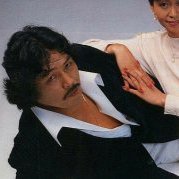
Update to #1: I am about a third of the way through the third part of Koizumi's Yoshimura bio.
-

Update: I am finished with the Koizumi Yoshimura bio, but it has left me somewhat wanting. I intend to write a Deluxe Profile on Yoshimura, and this feature wasn't quite enough.
I am currently hoping to acquire and transcribe a copy of Yoshimura's very rare 1973 autobiography, which Toudoukan currently has on sale for ¥19800.
-
-
Gantetsu Matsuoka (松岡巌鉄) Profession: Wrestler Real name: Masao Matsuoka (松岡政雄) Professional names: Seigozan, Gantetsu Matsuoka, The Great Ota, Masao Ota, Mr. Matsuoka Life: 11/25/1938-unknown Born: Wake (now Bizen), Okayama, Japan Career: 1962-1974 Height/Weight: 178cm/103kg (5’10”/227lbs.) Signature moves: Claw hold Promotions: Japan Wrestling Association Titles: NWA United States Tag Team [GCCW] (2x, w/Masio Koma), All Asia Tag Team [JWA] (1x, w/Great Kojika) Gantetsu Matsuoka was a sumo transplant in the early 60s who earned some success abroad and in the JWA's death knell. Masao Matsuoka entered the Oitekaze sumo stable in 1958, around the same time as his future tag partner Hiroshi Ueda. The following year, both men transferred under the wing of their trainer to the new Magaki stable. While Ueda transferred to pro wrestling in 1961 after a false start the year before, Matsuoka appears to have stuck with sumo through the end of 1961. Competing as Seigozan, he was promoted to the makushita division that year. Nevertheless, Matsuoka joined the Japan Wrestling Association in 1962, debuting that March with a loss to Katsurahama (Yonetaro Tanaka). He began wrestling under his birth name and adopted the ring name Gantetsu in 1963; although he experimented with his sumo shikona in 1964, Gantetsu Matsuoka would stick. According to the Great Kabuki, Matsuoka was a bully who relished in beating the JWA’s new apprentices; the fact that they would gang up on him and give him receipts during battle royals did not deter him. He also assisted Yusuf Turk in the hotel lobby assault upon the Great Togo in early 1968. In the summer of 1969, Matsuoka left on an excursion. First, he worked in Southeastern territories alongside his old friend Ueda. Notably, the two were part of the October 1970 match where Bobo Brazil broke the color barrier in Atlanta. As Ueda headed back home, Matsuoka worked for Gulf Coast Championship Wrestling in spring 1971, where he and Masio Koma won the NWA United States tag titles twice. Matsuoka left for Vancouver in late 1971; besides a handful of dates in Portland, this was where he spent the rest of his excursion. In autumn 1972, Gantetsu was brought back to the JWA. He had begun crushing an apple with his hand, in the tradition of Danny Hodge, and Matsuoka got a shot at Hodge’s NWA World Junior Heavyweight title shortly after his return. After Michiaki Yoshimura retired in early 1973, Matsuoka teamed up with Great Kojika to win the All Asia Tag Team titles before the promotion folded that spring. He was one of the nine wrestlers left when the JWA was absorbed into All Japan Pro Wrestling, and like his friend Ueda, he was someone who Giant Baba particularly did not want to work with. When the ex-JWA transplants were brought onto AJPW cards that summer, Baba snubbed the pair by having them work alternate dates, which cut their pay in half. Ueda and Matsuoka stuck around long enough to work Oki Shikina’s retirement show on October 9 before both left for the United States. While Ueda would work in the States through early 1976 before laying the groundwork for his great heel run back in Japan, Matsuoka is only known to have wrestled in America through late 1974. His whereabouts afterward are completely unknown.
-
Fujitayama (藤田山) Profession: Wrestler, Announcer Real name: Tadayoshi Fujita (藤田忠義) Professional names: Fujitayama Life: 2/11/1924-5/9/1969 Born: Tagawa, Fukuoka, Japan Career: 1955-1956 (as wrestler) Height/Weight: 167cm/113kg (5’6”/249lbs.) Signature moves: unknown Promotions: Japan Wrestling Association Titles: none Fujitayama was one of early puroresu’s shorter-lived sumo transplants. Tadayoshi Fujitayama entered the Kataonoha sumo stable and debuted in January 1939, shortly before his fifteenth birthday. When Kataonoha closed in 1942 after the retirement of its stablemaster, Kantaro Kaigetsu, Fujita was absorbed into Kagetsu’s former stable, Hanago. Tadayoshi received the shikona Fujitayama at that time, although he would switch his name back and forth about half a dozen times. Fujitayama continued to notch solid performances through the end of the Pacific War, as he never lost more than half of his matches in a tournament until November 1945. In 1947, he transferred again to the Takasago stable, and was promoted to the top makuuchi division. In 1951, the Takasago stable’s top wrestlers, led by stablemaster and yokozuna Maedayama, held the first exhibition tour of the United States since before the war. The tour was originally supposed to end that summer, but proved so popular that Fujitayama did not return to Japan until February 1952. He was penalized for this by a demotion to juryo, although he had been given a symbolic 5-10 record in the autumn tournament to recognize the contribution that he had made to the sport. After winning his first tournament back in the division with a 13-2 record—the only tournament win of his career—Fujitayama was promoted back to makuuchi. In 1953, the sumo schedule expanded from three to four tournaments per year, and it is evident that Fujitayama could not adapt. He officially retired at the last tournament of 1954 but had not competed since the first of the year. Fujitayama (right) with Primo Carnera, c.1955. Fujitayama joined the Japan Wrestling Association in 1955, contemporaneously with Azumafuji and Toyonobori. By a wide margin, his was the least notable tenure of the three. Tadayoshi began wrestling in the summer of that year and quit. During this time, the 5’6” Fujitayama teamed with the tallest man in puroresu at the time, and his former Hanago stablemate, Rashomon Tsunagoro. After just a year, Fujitayama quit wrestling, but according to the fanzine Showa Puroresu, he became a ring announcer. I do not know how long this lasted, but I presume that he had left the JWA by the end of the decade. Besides an acting career that included a bit part in Akira Kurosawa’s 1957 film The Lower Depths, I don’t have any information on Fujitayama before his death in 1969.
-
PART THREE: MAN UMANOSUKE [1985-2011] Umanosuke Ueda’s second NJPW run, which spanned ten tours from 1985 through 1987, was his last sustained tenure with a major puroresu promotion. He initially teamed up with his new protege, Hiro Saito, but they broke up acrimoniously in the middle of his second tour in March. For the rest of that tour, and a subsequent one in late summer, Ueda did his usual bit. Things got more interesting in 1986. In the midst of the UWF invasion angle, Ueda aligned himself with NJPW’s home team. On March 26, Ueda was part of the NJPW vs. UWF gauntlet match. His participation was minimal but memorable, as Umanosuke sacrificed himself to eliminate Akira Maeda in a double countout. That June, Ueda entered the IWGP League singles tournament, where he was eliminated in the B-block, by disqualification, in a singles match with Maeda. In 1987, he competed in the IWGP League once again. However, Ueda’s most intriguing appearance that year had been as a guest referee that January, in Tatsumi Fujinami’s blowoff match against Kengo Kimura. During the last stretch of his New Japan run, Ueda used “Spartan X”, the theme from Jackie Chan’s 1984 film Wheels on Meals, as entrance music, three years before Mitsuharu Misawa. Ueda in Takeshi's Castle. Ueda had been broadening his portfolio since the early eighties. A performance in 1982 dystopian punk musical Burst City was followed by appearances on Fuji TV variety shows such as Hyokin Tribe, which had segments devoted to a comedic interpretation of puroresu. In 1983, Umanosuke got a four-year gig filming commercials for Trident sugar-free gum. But if you recognize Ueda for anything outside wrestling, it is most likely that you know him as a guard in the cult classic game show Takeshi’s Castle (or in one of its many altered international forms, such as Spike TV’s Most Extreme Elimination Challenge in the US). Umanosuke began appearing on the program, which also featured Strong Kobayashi, during his time with NJPW. Back in Pensacola, Ueda worked for World Organization Wrestling, a small promotion formed by Flash Monroe and Ueda’s old friend Rip Tyler. Ueda won a title from Hacksaw Higgins, which got covered by Tokyo Sports, and Ueda had ambitious ideas. While the promotion itself folded after just a year, and Tyler left the business to run his Pensacola appliance store, Ueda continued to field the idea of defending the belt in Japan. Umanosuke had long been outspoken about puroresu’s pay gap between natives and gaikokujin, and he claimed that, if he could bring WOW to Japan, it would not be so. In 1990, NJPW streamlined its touring model, inspired by the Newborn UWF to cut back on its provincial shows. Ueda was strongly critical of “neglecting the regions”, and if he brought WOW to Japan, he vowed that they would only run provincial markets. It never materialized, but Ueda’s vision anticipated the birth of the Japanese indie scene. Ueda worked in Puerto Rico in 1991, and then returned to Japan for NJPW’s 20th Anniversary show on March 6, 1992. For the first time since 1984, he reunited with Tiger Jeet Singh to face Seiji Sakaguchi and Strong Kobayashi. Just like old times, they lost by DQ. Five months later, Umanosuke joined Kazuo Sakurada’s SWS splinter promotion Network Of Wrestling. After arriving unannounced on their first show, he teased a match for the WOW title with Kenji (George) Takano, but the Takano brothers left the company acrimoniously very soon after, and the WOW title was never mentioned again. Ueda worked with NOW frequently through the spring of 1994, where he reunited with Singh again. In the summer of 1993, he even got his son, a college football player, booked as Umanosuke Ueda Jr. For all this, though, the most remarkable bit of his Network run was possibly the grimiest match of his career: the Anything Goes Anywhere match on December 11, 1992 against Ishinriki. After working a freelance memorial show in April 1994 for Toshimitsu Naoi, the NOW wrestler who had died in a 1993 accident while driving the company truck, Ueda was inactive for two years. He stepped back to help Emiko run the restaurant and promote local shows, and to support her when she developed colon cancer in 1995. Then, an offer from IWA Japan came in early 1996. As Emiko recalled in a 2012 interview, she was strongly against it, but Ueda was compelled to return to the ring. She did get a promise from him that it would be his last tour. Unbeknownst to either of them, that would very soon be a foregone conclusion. The IWA Japan tour began with a final match alongside Singh, challenging Tarzan Goto and Mr. Gannosuke for the IWA and NWA World Tag Team titles. The latter, who had debuted for FMW in 1991, was yet another wrestler who had given his own spin on Umanosuke’s gimmick. The tour also saw Ueda wrestle a chain match against Goto, and thumbtack matches against Gannosuke and Keisuke Yamada. The latter match was the last of the tour, and afterwards, Ueda took a ride back to Tokyo with one of IWA Japan’s sales workers, instead of the tour bus, to keep kayfabe. As they drove down the Tohoku Expressway, their car was rear-ended by a semi-truck. The driver died instantly, while Ueda was propelled through the windshield and onto the asphalt road. He survived, but he felt nothing below his neck, and he would struggle with survivor's guilt in the years to come. None of Ueda’s family came to see him: only Emiko. She didn’t know how much longer she had at that point, but when they met in the hospital, she promised that she would take care of Hiroshi for as long as she lived. Ueda’s divorce proceedings protracted over the next three years, as his ex-wife sought alimony from the compensation that Ueda would receive from the transportation company. On April 16, 1998, Junzo Hasegawa (Yoshinosato) promoted his final show, under the umbrella of his Rikidozan Alumni Association: a retirement show in Kumamoto for Ueda, at which Umanosuke appeared in a wheelchair. In the summer of 1999, the divorce was finalized. Just two days later, the couple submitted their marriage certificate to Kumamoto City Hall. Hiroshi and Emiko moved across Kyushu island to Emiko’s hometown of Usuki and opened the Uedaya thrift store. Ueda lived with severe pain, and his lungs had been reduced to a third of their previous capacity, but he recovered enough to make public speaking engagements, and regained some feeling in his upper body. During his active career, Ueda had kept his true character outside the ring from being reported. He used to visit an orphanage of children who knew his nephew, and had later volunteered with an organization that held pottery classes for children with Downs syndrome. In a 2008 television program, Ueda is seen giving a talk at a school in 2006. One day, when he made a speech at a nursing home, an elderly mark insinuated that Ueda had deserved his accident for the things he had done in the ring. However, Hiroshi was not offended; as he explained to Emiko, he was grateful that that man had taken pro-wrestling seriously. It was in keeping with how Ueda had carried himself throughout his career. He may have been a heel, but he had also carried himself as a last bastion of the Rikidozan era. In 2009, Oita-based indie wrestler VINNI began working as Umanosuke Ueda. While Ueda himself could not make the trip, he had clearly given his blessing, as Emiko arrived at the new Umanosuke’s debut to give him her husband’s old gown and kendo stick. Umanosuke II later won the WOW title. Hiroshi Ueda died of asphyxiation two years later, in November 2011. Umanosuke and Emiko attend an independent show in 2006.
-
PART TWO: GOLDEN WOLF [1977-1984] NJPW’s greatest villain, Tiger Jeet Singh (c.1978), received a much-needed facelift when he began working with Ueda in 1977. Since nearly the beginning of its time on television, New Japan Pro-Wrestling had featured Tiger Jeet Singh as its top heel. With sabers, fireballs, and staged assaults at Shinjuku department stores, the Indo-Canadian was the first true star that NJPW ever made, in a time when Giant Baba’s connections in the American industry froze his competition out of booking any bigger names. As he entered his fourth year working for the company, though, Singh was getting a little stale. He had branched out into the tag title scene in 1976. His temporary teams with Brutus Mulumba and Gama Singh had put shine on Seiji Sakaguchi’s new tag team with Strong Kobayashi (as Inoki concentrated on singles), first in a match for the vacant NWA North American tag titles, then in that summer’s Asian Tag Team League. On the first tour of 1977, Singh began a more stable partnership with Umanosuke Ueda. Their first shot at the NWANA titles, a heated match on January 14 in Fukuoka, saw Singh and Ueda work Kobayashi’s hurt arm to win the first fall, but the bout ended in a no-contest. The duo sure made the most of their second shot, held in Osaka on February 2. After winning the first fall in seventeen minutes, Singh crossed the line by breaking Kobayashi’s arm in a work. This disqualified the heels to lose the second fall, but Kobayashi was unable to stand, much less wrestle a third fall. Therefore, Singh and Ueda became tag champions by forfeit. They held the titles for nearly six months. When the tour ended with Singh challenging Inoki for the NWF title, the ring was fenced off to prevent Ueda’s interference. Singh and Ueda were linked to Inoki’s broader on-again, off-again storyline against Johnny Powers, who had been plotting for years to get the NWF title off of him. On March 31 and April 1, 1977, NJPW had booked the Kuramae Kokugikan for two straight nights, which coincided with network NET TV’s rebrand as TV Asahi at the start of the fiscal year. It had been over twenty years since a puroresu promotion had been so bold as to book the Sumo Hall on back-to-back dates. The company needed a big match to maintain the momentum across two shows. On the first night, Inoki defended the NWF strap against Johnny Powers for the last time. On the second night, Inoki and Sakaguchi’s “Golden Tag Team” reunited to challenge Singh and Ueda for the tag titles, with Lou Thesz as guest referee. After assaulting Ueda’s former senpai Kokichi Endo in a memorable backstage segment, the heels walked out as champions after Singh knocked Thesz down in the third fall to be disqualified. That June, Sakaguchi and Kobayashi reunited to challenge for the titles in Norfolk, Virginia, but Singh and Ueda retained again. It wasn't until the Big Summer Series that Seiji and Strong brought the belts back home, in a July show in Fukuoka. Ueda worked for his old Southeast territories throughout 1977, but late in the year, Mr. Ito started appearing for Angelo Poffo’s outlaw ICW promotion. Ueda’s transition into a heel was complete, and he had dyed his hair fully blond by 1978. This came with personal consequences at the time, as his villainous character initially did great damage to his relationship with his young nephew, and also led him and his family to remain settled in Pensacola, Florida. But it was worth it. As Singh himself would tell you, Ueda was the greatest partner that he ever had. He drew out Singh’s potential by playing a supporting role. Singh had caused problems for NJPW by hitting yakuza in the audience during his entrances, so Ueda kept Singh’s character work from becoming a liability by standing shoulder-to-shoulder with him during entrances. When Singh went on his rampages in the crowd, Ueda hung close and surreptitiously protected audience members who were not quick enough to evade him. As Singh claimed many years later in an interview with Weekly Pro Wrestling, Umanosuke was the first true friend that he had made when working with New Japan. He even began wearing a turban at Ueda’s suggestion. Ueda and Inoki wage war in the Budokan, a blowoff years in the making. Singh and Ueda returned to New Japan for the first tour of 1978. This came with another tag title shot in Nagoya, but much more notably, this tour saw Ueda get his singles match with Inoki: the non-title “nail floor death match” at the Nippon Budokan on February 8. The stipulation, which surrounded the ring with wooden boards and thousands of five-inch nails, was the product of a brainstorm session between Inoki and NJPW sales wunderkind Naoki Otsuka, who had initially proposed surrounding the ring with broken glass bottles. When Otsuka had Ichiro Furutachi explain the stipulation one week before the show, on World Pro Wrestling’s taping in Sapporo, the result was the most “explosive” surge in ticket sales that Otsuka ever saw. It was an early vindication of Otsuka’s new airline-inspired telephone preorder system, in which customers called the NJPW sales department directly to reserve tickets (with no cancellation fee). Usually, the sales staff got by with just one notebook of names for a major-market show, but they needed three for this show. The company made 14 million yen in same-day sales alone, nearly six times the amount that even a big-market show would usually make. Neither man would take a bump onto those nails, no matter how hard Ueda tried to push Inoki out. Inoki won in eleven minutes by knockout. Assuming that WrestlingData’s records are reliable, one can only presume that Ueda had burned his bridge with the Southeastern promoters by working dates for Poffo, for after he returned to the States, he took four months off before he began work for the LeBells in NWA Hollywood. Apparently, there were rumors at the time that Ueda was seeking a transfer back to AJPW, but the fact that he came back to work for NJPW’s closest American allies leads me to believe that this was an angle. (Note how Ryuma Go was working with NWAHW around this time, as a smokescreen for being with New Japan, and had held a press conference at an All Japan show to declare his "independence".) Now billed as Professor Ito, Ueda won the promotion’s tag titles in summer 1978 with Pak Choo: that is, NJPW’s Kengo Kimura. When Umanosuke returned to Nooj, this led to a brief but ugly breakup with Singh. On September 19 in Osaka, Singh and Ueda squared off with Inoki as referee. That winter, Ueda entered NJPW’s Pre-Japan Championship League, a tournament which counterprogrammed the IWE’s Open League by pitting NJPW talent against a loose band of Japanese freelancers led by Hiro Matsuda. Ueda challenged for the tag titles again in December, this time with Thunder Sugiyama. NJPW’s partnership with the IWE saw Ueda return to the promotion where he had begun his heel run. By the time that Ueda returned to Japan for the second Nooj tour of 1979, the company had begun a partnership with the IWE. This opened things up for Umanosuke, who returned to the promotion where he had begun his native heel run for three full tours. While Ueda worked with Singh again in Nooj, he had also taken a clear hit in the pecking order of New Japan heels. According to the fanzine Showa Puroresu, Ueda was originally planned to win a second tag title in the company with Masa Saito, in the program which would see Riki Choshu take Kobayashi’s place as Sakaguchi’s partner, but Ueda was replaced by Hiro Matsuda. Sakaguchi had won his own pet singles title against Johnny Powers that January, and he made a pair of defenses against Ueda to start his only run with the belt. Umanosuke’s Kokusai appearances were more interesting. He got two shots at the ace he had probably feigned an injury to avoid putting over in 1976, and only lost by disqualification both times. He also got three shots at Mighty Inoue & Animal Hamaguchi’s tag titles, each time with a different partner: Masa Saito, Kintaro Oki, and Yasu Fujii. On his last full tour with the IWE, Ueda wrestled some matches alongside Goro Tsurumi, who had made a heel turn of his own. Tsurumi was the first wrestler to put their own spin on Umanosuke’s shtick, and far from the last. In 1980, the Golden Wolf had an unremarkable summer tour with New Japan, followed by autumn shots at the tag titles with Singh, and at Sakaguchi’s second pet title (third if you count the one he won in South Africa!), the WWF North American Heavyweight belt. A week before that tour, on October 4, Ueda made one last appearance for Kokusai, challenging Oki for the IWA world title after Eduoard Carpentier had canceled. Ueda first met Emiko, who later became his second wife and caregiver, in 1982. In summer 1981, Singh transferred to AJPW in anger over New Japan’s signing of Abdullah the Butcher. His first tour with the company saw him team up with, of all people, Bobby Heenan, but after one last summer tour with New Japan, Ueda followed his primary partner. They got a match for Giant Baba & Jumbo Tsuruta’s NWA International Tag Team titles on Ueda’s first tour, and entered the 1981 Real World Tag League as a unit. In early 1982, Ueda and Baba headlined a Kagoshima show with a singles match. While I could not find records of Ueda’s work in the States between his last NWA Hollywood run in 1981, and a Mid-South run in 1984, he apparently did work in WCCW and Florida under a Gary Hart gimmick named Tengu. However, Ueda’s first full year back with All Japan was more notable for personal reasons than for career accomplishments. After a show in Kumamoto, Ueda stopped at a snack shop for food. As it happened, its owner Emiko had just partnered with AJPW as a ticket seller. The two began a professional relationship in this capacity, but Ueda would also start helping out at the store. While NJPW had only run one singles match between Ueda and Inoki, All Japan went to the well four times. The most notable of these matches was on March 3, 1983. Two days before, Ueda had wrestled a lumberjack match against Genichiro Tenryu. Goro Tsurumi had given Ueda a wrench to use in the match, and then allowed him to escape. This led Tsurumi to receive a six-month kayfabe suspension by the PWF (in truth, he went on a West German excursion). This tour, which saw the Japanese debut of the Great Kabuki, had been the first in All Japan history to be held without Baba, who was overseas chasing Harley Race for the PWF Heavyweight title. However, Ueda and Singh threatened to boycott the last show of the tour if Baba did not return for it. In an extremely rare result for a Baba match, Ueda lost by referee stoppage as the Giant broke his arm. This tour was the first in AJPW’s history to turn a profit without factoring in network funds, and as a fan article suggests, this unusual display may have been Baba calling an audible to “make his presence felt”. It is also worth noting that Ueda had been quite popular with and outspoken in the wrestling press, and had openly criticized the likes of Hisashi Shinma and Motoko Baba. Whatever the case, Umanosuke did not return to the ring until a summer tour with All Japan, where he and Singh won their last tag titles in a two-week run with the NWAIH belts. The 1983 RWTL would be their last significant showing as a team, where they notched a middling six points. Besides a one-off appearance on the UWF’s first show on April 11, Ueda spent most of 1984 with AJPW. Umanosuke and Singh got a pair of tag title shots against Baba and Jumbo, Ueda got an early shot at Tenryu’s NWA United National title, and the Tengu gimmick was brought out for a one-off singles match against Kabuki. At a June 14 house show in Korakuen Hall, Ueda was part of an eight-man elimination match, a clear attempt to respond to NJPW’s then-new gauntlet match stipulation. At some point in the year, Ueda was contacted by Hiro Saito, who was then working for Stampede Wrestling. Hiro had been ordered by Stu Hart to dye his hair blond, so he contacted Ueda to seek his blessing. Umanosuke not only granted it, but he also took Saito under his wing. By the end of the year, Ueda had jumped ship back to New Japan; I could not find any specific backstage info, but it is apparent that Ueda and Baba had never fully buried the hatchet. (In 1992, Ueda was deeply angered that Baba did not call to tell him when Motoshi Okuma died.) Ueda returns to New Japan in December 1984.
-
Umanosuke Ueda (上田馬之助) [KinchStalker Deluxe Profile #2] Profession: Wrestler Real name: Hiroshi Ueda Professional names: Hiroshi Ueda, Umanosuke Ueda, Professor Ito, Great Ito, Mr. Ito, Tengu Life: 6/20/1940-12/21/2011 Born: Kaifu (now Yatomi), Aichi, Japan Career: 1960-1996 (“retired” 1998) Height/Weight: 190cm/118kg (6’3”/260lbs.) Signature moves: Cobra claw, throat thrust, cross-chop, double chickenwing (Kimura lock), weapon attack Promotions: Japan Wrestling Association, All Japan Pro-Wrestling, International Wrestling Enterprise, New Japan Pro-Wrestling, NOW, IWA Japan Titles: NWA World Tag Team [NWA Mid-America] (2x, w/Tojo Yamamoto), NWA World Tag Team/NWA Western States Tag Team [Western States Sports] (2x, w/Chati Yokouchi), NWA Georgia Tag Team [Georgia Championship Wrestling] (1x, w/Chati Yokouchi), NWA International Tag Team [JWA/AJPW] (2x: 1x w/Kintaro Oki, 1x w/Tiger Jeet Singh), IWA World Heavyweight [IWE] (1x), NWA North American Tag Team [NJPW] (1x, w/Tiger Jeet Singh), NWA Americas Tag Team [NWA Hollywood] (1x, w/Pak Choo) Fifteen years into his career, the outcast Umanosuke Ueda used territory heel experience and real-life heat to reinvent himself as puroresu’s first great native heel, and one of its most influential characters. PART ONE: TRAITOR [1961-1976] Ueda (left) eats chanko with Antonio Inoki and another JWA wrestler, c.1963. Hiroshi Ueda dropped out of high school to join the Oitekaze sumo stable. A few months after his debut in spring 1958, he was among the crop of talent which jumped ship with their now-independent trainer to wrestle for the new Magaki stable. Ueda competed as Uedayama and then Kaifunishiki. He left Magaki in early 1960 to join the Japan Wrestling Association, at the invitation of former stablemate Koichi Hayashi. He first entered at some point before Shohei Baba and Kanji Inoki joined the company in April, but this was a false start, as he returned home and continued to compete in sumo through the autumn. But Ueda had committed by the following year, and in April 1961, he debuted with a loss to Mitsuaki Hirai. Hiroshi, who was assigned to Kokichi Endo as a valet, was among those reared in the kimekko tradition, a rudimentary form of shoot grappling derived from amateur wrestling and Kosen judo and instructed by JWA coaches Isao Yoshiwara and Kiyotaka Otsubo. As the stories go, Ueda was among the best at it, with particular specialty in arm and Kimura locks. However, this skill was not complemented by in-ring flashiness, and Ueda developed a reputation for particuarly dry matches, which earned him disparaging nicknames like “Sleepy Shiro” and “Toilet Time Ueda”. Ueda first worked under his real name, but on November 9, 1962, the same night that Kanji Inoki first wrestled as Antonio, Ueda wrestled his first match billed as Umanosuke (ooo-mahn-OHS-kay) Ueda. It was one of several ring names that Toyonobori had nicked from the historical characters of period dramas; Umanosuke Ueda was a 19th-century samurai who, after the Meiji Restoration, had gotten around the civilian ban on swords by becoming a police instructor. In autumn 1963, during a tour of the Kansai region, the JWA held the Fangs of Kansai tournament. Fourteen undercard wrestlers competed in single-elimination format, and Ueda and Koichi Hayashi got to skip the first round due to this unusual number. Ueda beat Iwakichi Hirano and Isao Yoshiwara to advance to the finals. On October 16 in Himeji, Ueda defeated Kantaro Hoshino in less than four minutes to win the tournament. On the first tour of 1965, Ueda entered another tournament, the eight-man Mitsubishi Cup, and went over Matsuoka, Hoshino, and Tadaharu Tanaka to win. Ueda and Matsuoka as Mr. Ito and the Great Ota. In 1966, Ueda was selected to compete in the 8th World Big League tournament. Soon afterward, he left for his first overseas excursion. Billed as Professor Ito, Ueda began with a summer stint with the Worldwide Wrestling Associates (later NWA Hollywood), then moved east to work for Nick Gulas in NWA Mid-America until the following March. In early 1967, Ueda teamed up with Tojo Yamamoto for two brief reigns with the promotion’s version of the NWA World Tag Team titles. When he returned to the JWA that spring, Ueda experimented with the name Great Ito for a couple tours before reverting to Umanosuke that July. As 1968 began, Ueda left again for a longer excursion. Over the next three years, Mr. Ito worked from Georgia to west Texas. He worked programs with Danny Hodge across a pair of stints with NWA Tri-State, and in early 1970 held the NWA Junior Heavyweight title for a week in a non-canonical reign. In Western States Sports and Georgia Championship Wrestling, Ueda teamed up with Chati Yokouchi for multiple tag titles. Ueda claimed in 2007 that he shot on his former tag partner Tojo Yamamoto during a match in Tennessee for stiffing him on pay. Later on, when Ueda worked in Florida, he claimed that he earned respect as a shooter from Eddie Graham and Bob Roop. This excursion also saw Ueda team up with his old sumo friend Gantetsu Matsuoka, who worked as the Great Ota. On October 9, 1970, the team was part of history. That was the night when Bobo Brazil broke the color barrier in Atlanta, teaming up with El Mongol to beat Ito and Ota in the Atlanta City Auditorium. Ueda returned to the JWA in spring 1971, just in time to enter the 13th World Big League. In the autumn, Ueda teamed with Great Kojika for the 2nd NWA Tag Team League. Ueda’s complicity and subsequent betrayal in the infamous JWA “phantom coup”, which cost Inoki his job, would be the piece of real-life lore that made his native heel run work. As 1971 ended, Ueda became a central conspirator in the plan to reform the company. A couple days after Antonio Inoki’s wedding to Mitsuko Baisho, in the locker room of Korakuen Hall, Ueda remarked that something had to be done, and Inoki agreed. With the help of event promoter, accountant, and Inoki business associate Akimasa Kimura, the men planned to rally their coworkers to support a reform petition during the final tour of the year and brought Baba on board. On November 19, they got most of the locker room to sign off on the proposal. One week later, in a Shinjuku snack bar, Ueda disclosed to executives Junzo Yoshinosato and Michiaki Yoshimura that Inoki had planned a more radical course than the meeting that had been agreed upon; namely, that Kimura intended to abuse his power as auditor to surreptitiously promote Inoki and himself to the top executive positions in the company. To this day, the circumstances of the infamous phantom coup and how it fell apart have not been fully settled; I myself concur with historian Etsuji Koizumi, who recently speculated that the official narrative was partially fabricated to mollify Baba and Ueda's complicity. There have been various theories over the years as to why Ueda ratted Inoki out, which range from not receiving a seat on the board of directors in the coup, to concern that Baba and Inoki’s disdain for the JWA’s ex-sumo wrestlers would put his job at risk. Four years before his death, Ueda claimed that Baba had leaked the plan before him. JWA accountant Masakazu Misawa later claimed that Kintaro Oki had tipped the executives off even before Ueda had been summoned to that snack bar. Whatever the case, when the coup fell apart at a December 5 meeting, Inoki called Ueda a traitor, and the label stuck. Ueda remained with the JWA as it sunk over the next sixteen months. On its penultimate tour in March 1973, he won his first title in his native country, as he took the place of the departing Seiji Sakaguchi to team with Oki on the 6th, and the two beat Johnny Valentine and Killer Karl Krupp to win the NWA International Tag Team titles. However, the following month saw the pair drop the belts to Krupp and Fritz von Erich. Ueda and Matsuoka left AJPW in autumn 1973. After Oki had rallied the JWA against an NJPW merger that would have saved them, the company had no television support, and struggled to hold a last handful of shows. Yoshinosato would work out a deal with Rikidozan widow and AJPW director Keiko Momota to have the company’s nine remaining wrestlers join All Japan. Ueda signed a three-year contract with Nippon TV, instead of AJPW itself, on April 25, 1973. However, Baba saw no great use for most of these men, and when he was forced to bring them aboard by the AJPW board, his only consolation was that he retained the right to book them however he wished. When the ex-JWA talent started work for Baba that summer, he snubbed Ueda and Matsuoka, who he especially did not want in the company, by booking them to wrestle on alternate dates. Bear in mind that these men were paid per appearance! Ueda tried to rally his peers to push Oki, who had fallen into line with Baba (and was being booked relatively well, for the moment), to protest their treatment. This was unsuccessful. One night, Ueda went out drinking with Matty Suzuki to ask his advice, and that was when he came up with his next move. The NTV contract precluded him from finding work with New Japan or Kokusai, but it wouldn’t prevent him from working overseas again, where he could wait for it to lapse. Ueda and Matsuoka had decided to leave by October but stayed on board for the first dates of the Giant Series tour, to work on the November 9 show at the Kuramae Kokugikan. Among other things, this show saw the starmaking television debut of Tomomi Tsuruta, but it also featured a retirement ceremony for JWA referee Oki Shikina. According to one anecdote, AJPW did not give Shikina a cut of that show’s sales (as was common practice for retirement shows), so the pair gave him a parting gift from what they had made. After Ueda’s loss to Larry O’Day, he returned to the southeastern United States, working across NWA Tri-State, GCCW, and CWF as Mr. Ito. On New Year’s Day, 1976, Ueda stated his intent to return to Japan when his contract ended on April 25 and issued challenges to Baba and Inoki. Ueda had burned his bridge with Baba by leaving for the States without Baba’s approval. He had figured that Inoki would have more interest anyway, as an Inoki-Ueda match was similar to Antonio’s heated, successful matches against Strong Kobayashi and Kintaro Oki in 1974. However, Inoki also refused. Ueda was not a Kobayashi or an Oki, and on top of Inoki’s lingering resentment over the phantom coup, he was shifting his focus towards a new avenue of promoting his company: that is, the proto-MMA fights that would later be known as ishin kakutogi. With Willem Ruska and Muhammad Ali on the horizon, Ueda would be a step back. On January 25, Ueda sent a challenge to puroresu’s third ace, Rusher Kimura. In its verbiage, Umanosuke made appeals to Japan’s need for a unified commission to decide its “true champion”, a bit of marketing that Inoki had used to great effect over the previous few years. It had allowed Inoki to get himself over as pursuing a match with Baba while conveniently ignoring the conflicting network interests which made that match impossible. In 1975, Kimura had attempted to call Inoki on that bluff by pursuing a match with him, but Inoki had shot that down. It was a smart card for Ueda to play. Ueda consulted his former boss Yoshinosato, who had since landed a color commentary gig with the IWE. At Junzo’s suggestion, he negotiated with Kokusai president Isao Yoshiwara to work on the late spring’s Big Challenge Series. Ueda continued to work in the States through early May. With friends Rip Tyler and Eddie Sullivan in tow, he returned to Japan with a startling new look, having dyed his bangs blonde. Ueda poses with the IWA World Heavyweight title on June 11, 1976. The “speckled wolf” went over Sullivan in his first match back home on May 23. Soon, though, Ueda shifted to working matches against IWE’s native talent. While no footage survives from Ueda’s 1976 stint with Kokusai, it is known through match reports that he worked a somewhat more technical style during this “speckled wolf” run than he would later on, marking it as a transitional period from his pre-IWE work in Japan. On June 11, Umanosuke got a shot at the IWA world title. After downing referee Osamu Abe with a shoulder tackle, he used a foreign object to down Rusher Kimura for the pinfall. As the bloodied Ueda smugly grinned for the cameras, Japan had found its first great native heel. It is not strictly correct to call Umanosuke Ueda the first native heel in puroresu. The Great Togo, a second-generation Japanese-American, had done the heel bit during his tours abroad with the JWA. Mr. Chin had assaulted his foes with mouthwash and wooden sandals. Seven years earlier, Chati Yokouchi had turned heel in the IWE. And Ueda was far from the first to let his style as a territory heel bleed into his in-ring work back home. But Togo had not so much enraged as confused Japanese audiences. Chin’s shtick had been confined to JWA undercards, and at the time was probably perceived more as early puroresu comedy, like Yusuf Turk. Yokouchi's heel turn was squandered on his second and final tour with the company, after which he was never seen in Japan again. Finally, the unscrupulous stylings of puroresu’s “rough”-style workers did not translate into any sort of heat that drew tickets; it was received more as a difference in approach than as a moral failure, not unlike a rudo in lucha libre. All of this is to say that, no matter what technicalities you wish to cite, Ueda’s reinvention was a genuine watershed moment in the development of puroresu. No native worker had fully committed to the bit, and only Ueda had the heat to make it work. Ueda was booked for the IWE’s following tour in July. Two weeks before it began, though, Ueda went into business for himself. On June 26, the same day that Inoki fought Muhammad Ali, Ueda resubmitted his challenge to the ace of New Japan. The added clout of an IWA world title piqued the interest of top NJPW executive and “radical instigator” Hisashi Shinma, who had courted Strong Kobayashi to jump ship from Kokusai and wrestle Inoki in the match that started New Japan’s first golden age. Shinma stated that an Inoki match could happen, but first, Ueda would have to come to NJPW as IWE champion and defeat either Sakaguchi or Kobayashi in a singles match. This would not happen. Three weeks after an unsuccessful shot at the IWA tag titles with Thunder Sugiyama, Ueda defended his title in a Rusher rematch. This cage match—or “wire mesh deathmatch”, in Kokusai parlance—ended in a no-contest when the Super Assassin (Roger Smith) and Mighty Inoue climbed into the cage to interfere. Ueda claimed that he injured his left shoulder and vacated the title; Inoue asserts that Ueda fabricated this in order to not have to give Rusher his heat back at the end of the tour. Whatever the case, the injury also prevented him from competing for New Japan, in an August 5 singles match that had already been booked against Kobayashi. That night in Tokyo, though, Ueda entered the ring after Inoki’s NWF Heavyweight title defense against Tiger Jeet Singh to challenge Antonio directly. Inoki rejected the challenge and the two came to blows. Two months later, on the night that Inoki fought Andre the Giant, he and Umanosuke entered another scuffle. Ueda crashes NJPW’s show on October 7, 1976.
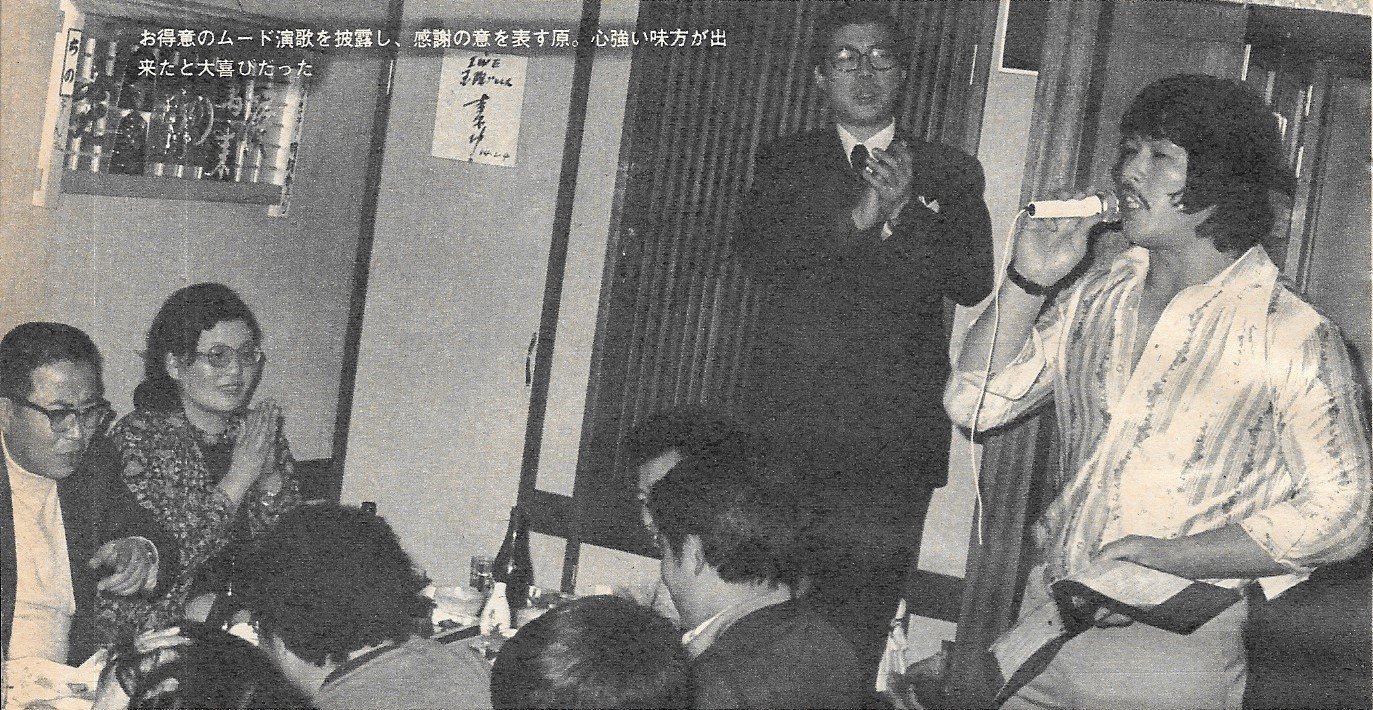
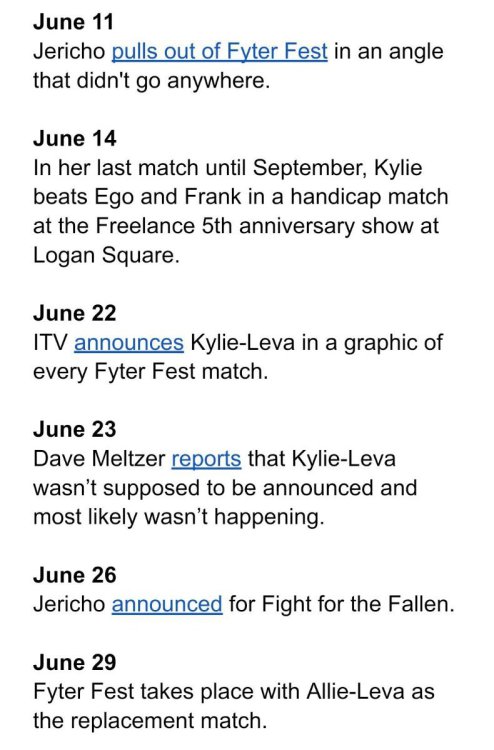
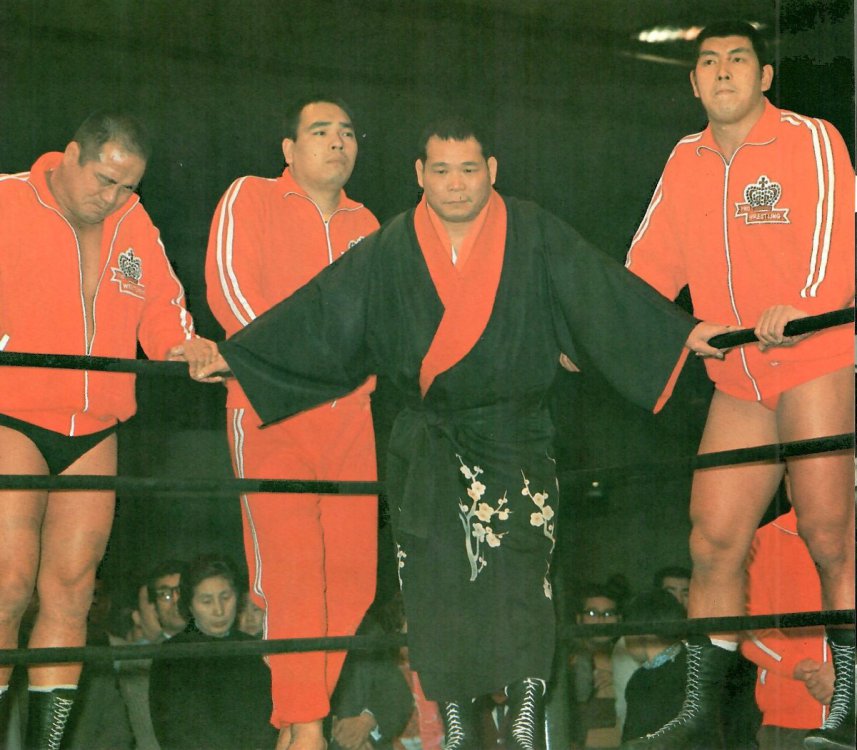
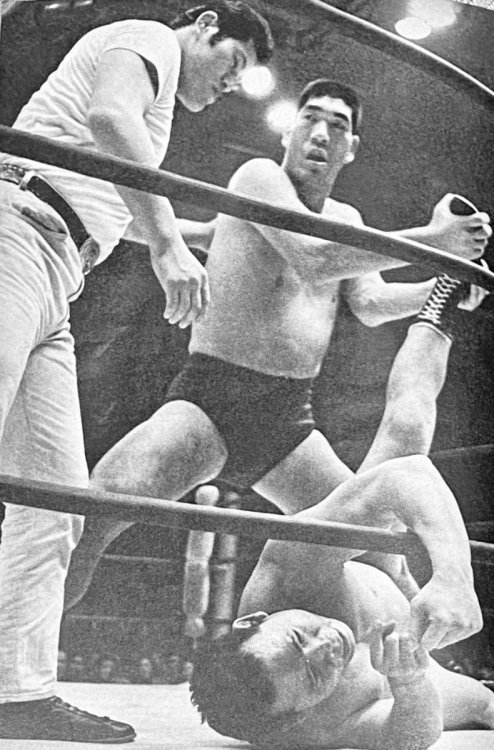
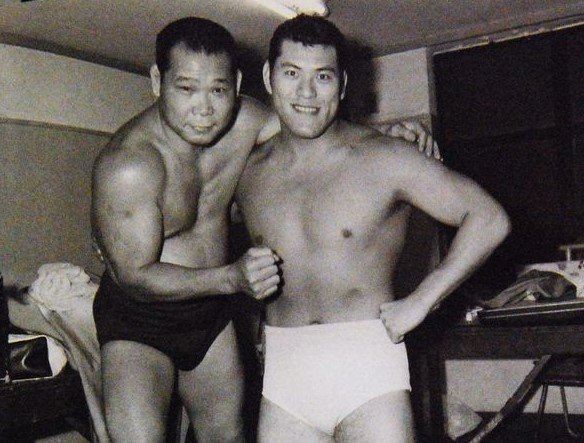
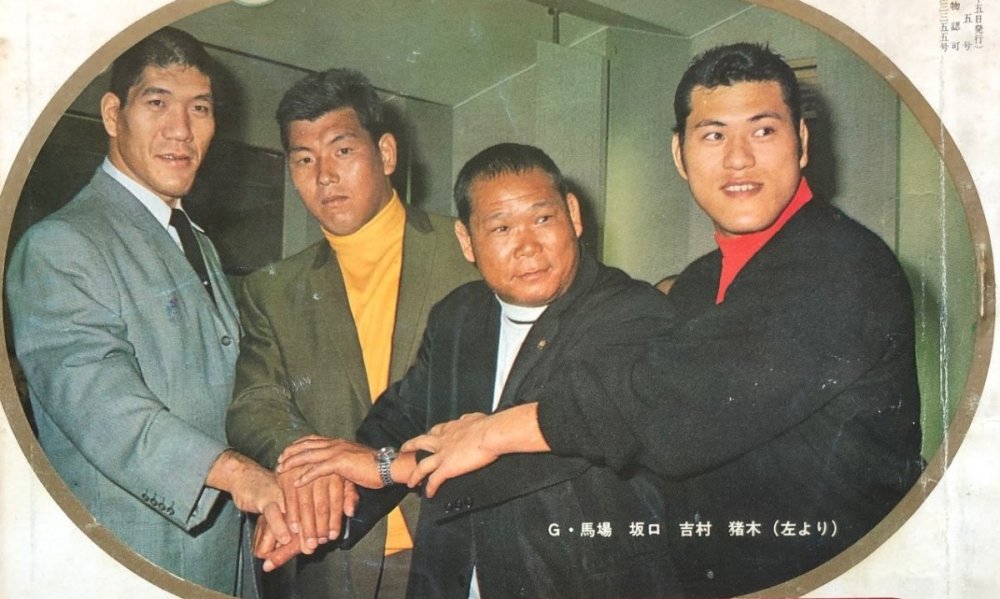
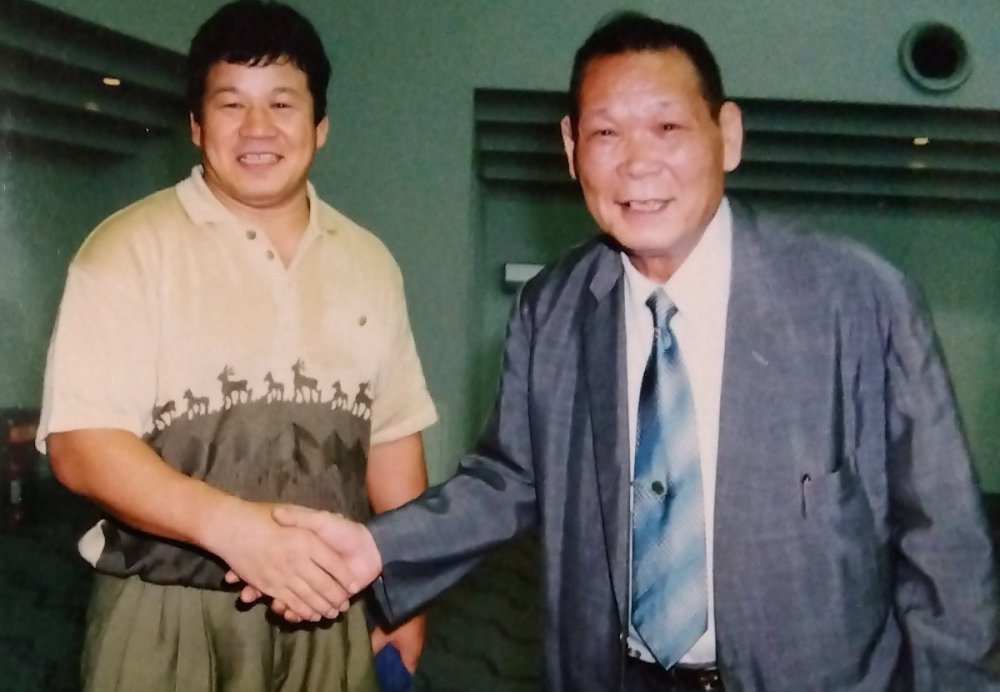
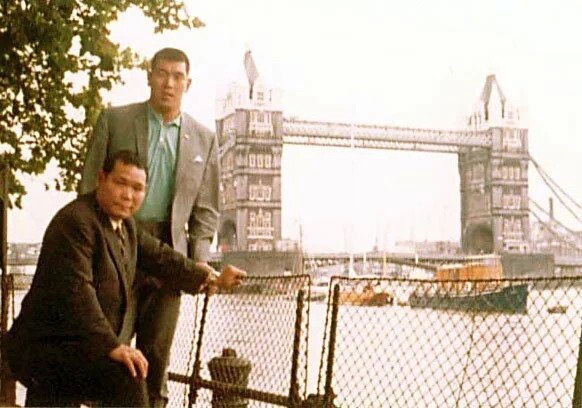
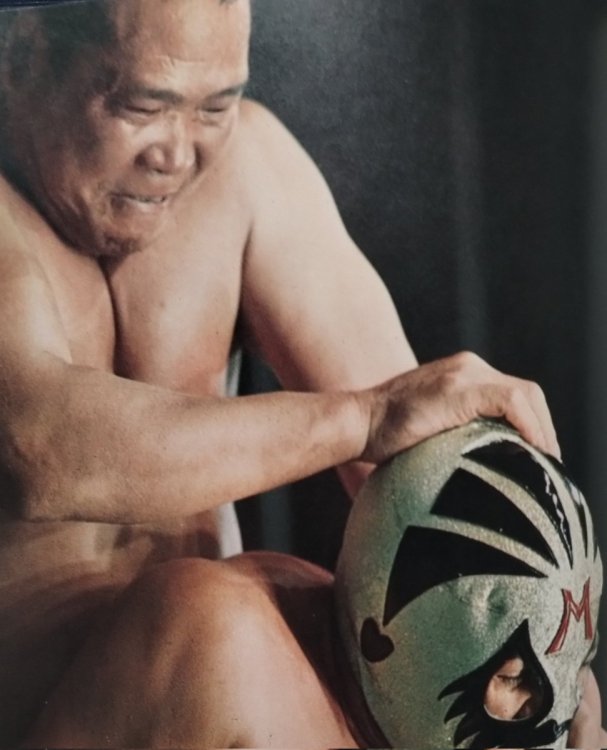
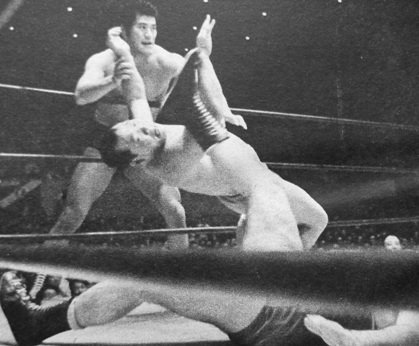
.thumb.jpg.fd9216591b699f2d67c54a5362145acd.jpg)
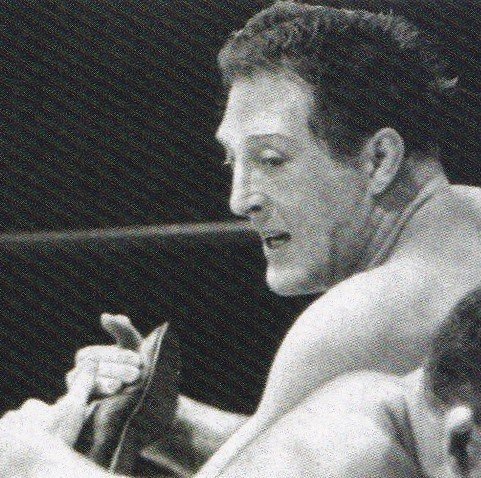
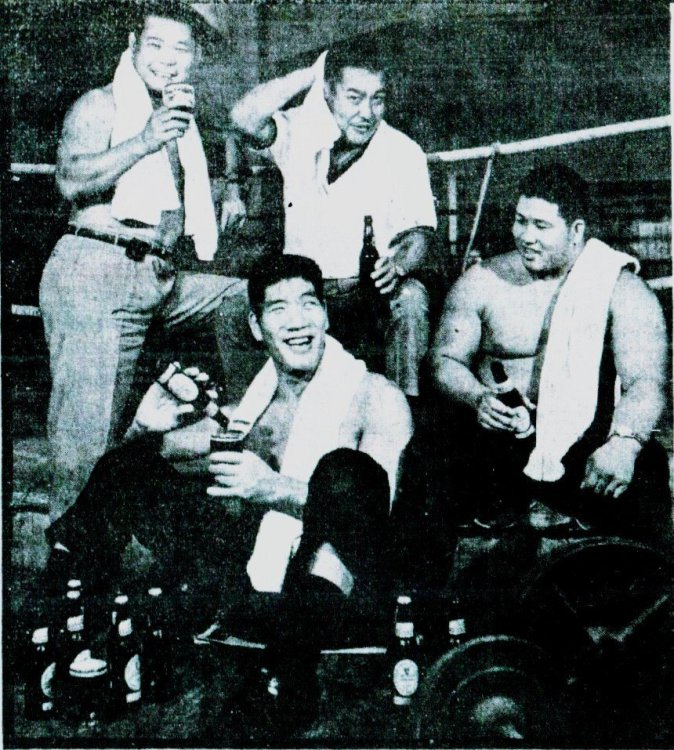
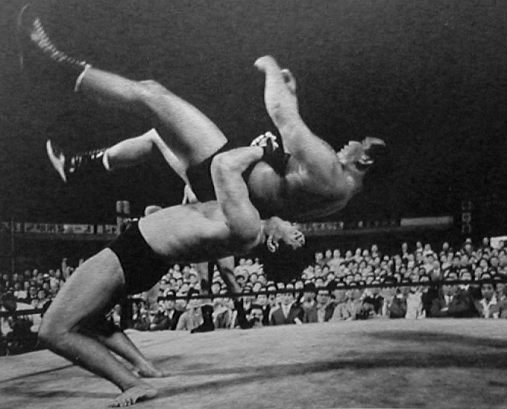
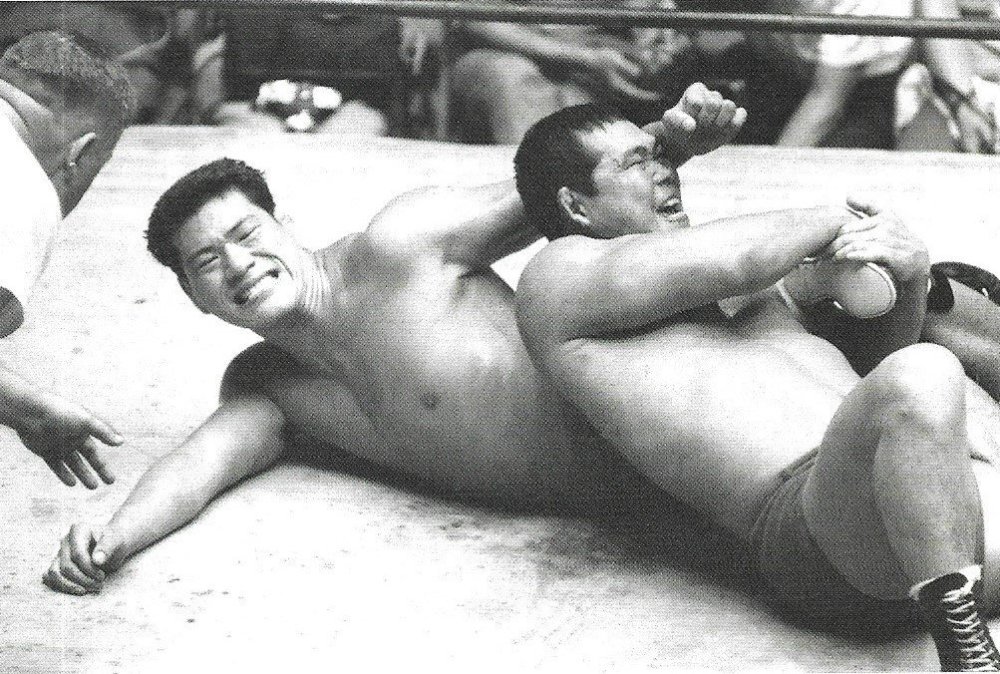
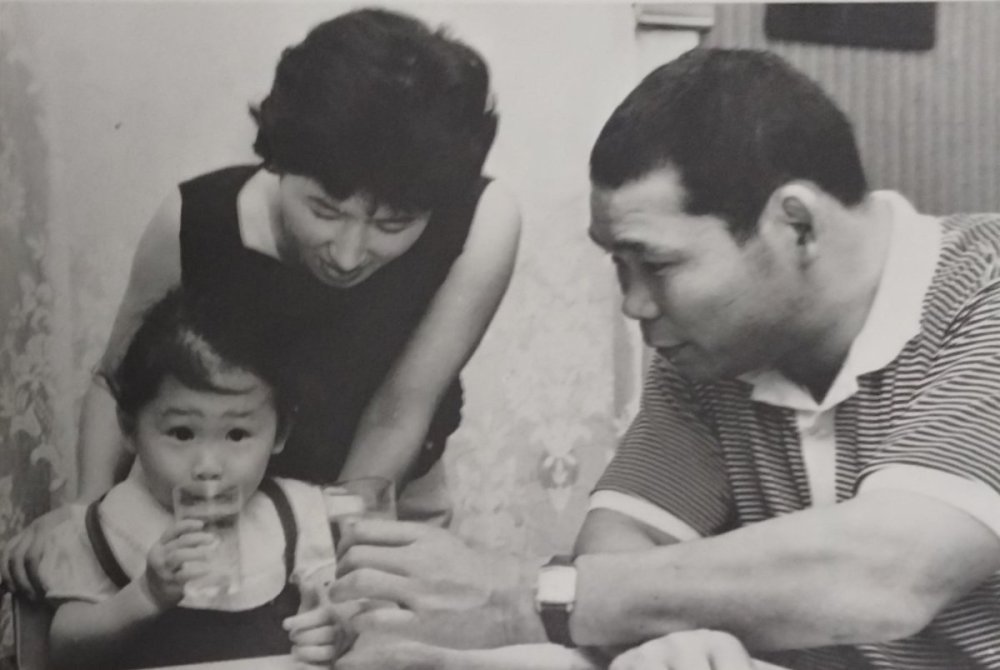
.jpg.044bc18a5e739da325556a5e20aea569.jpg.2eb3af8d2a89e744e7436d5829e30205.jpg)
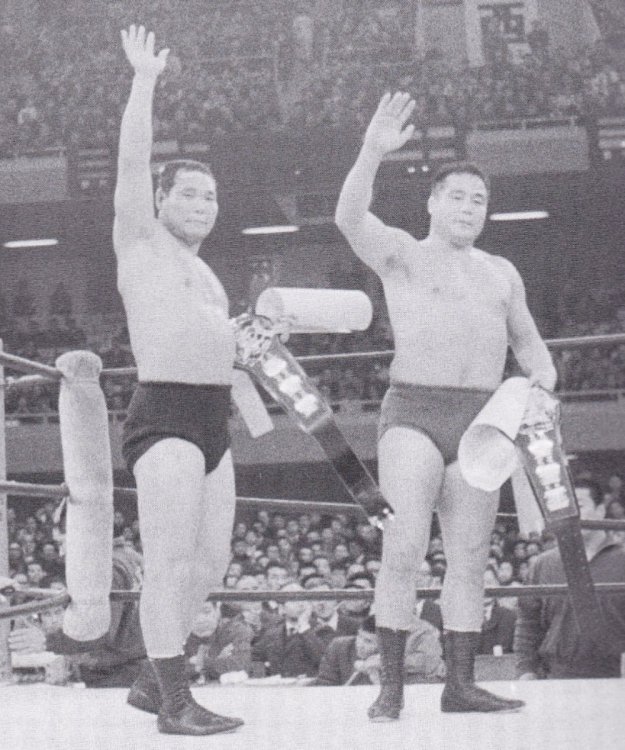
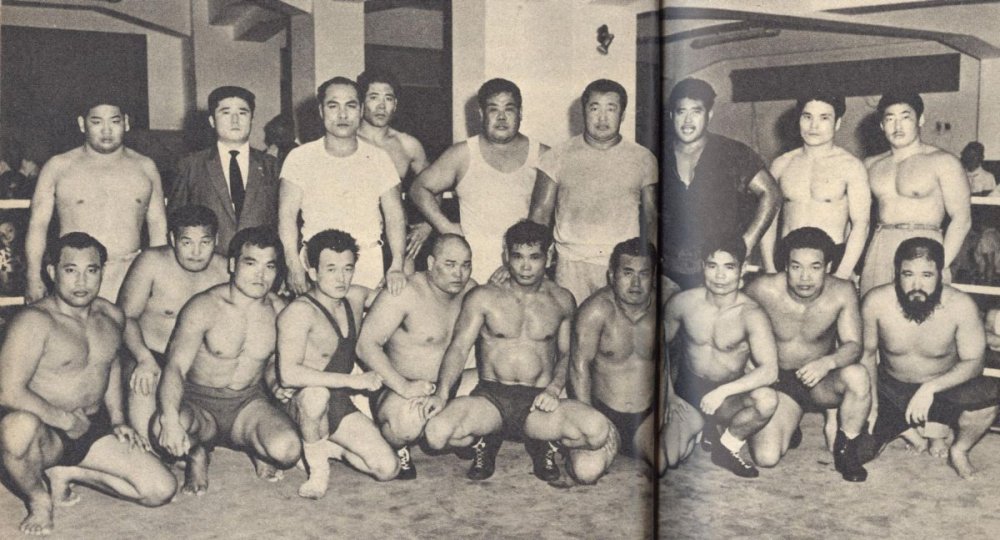
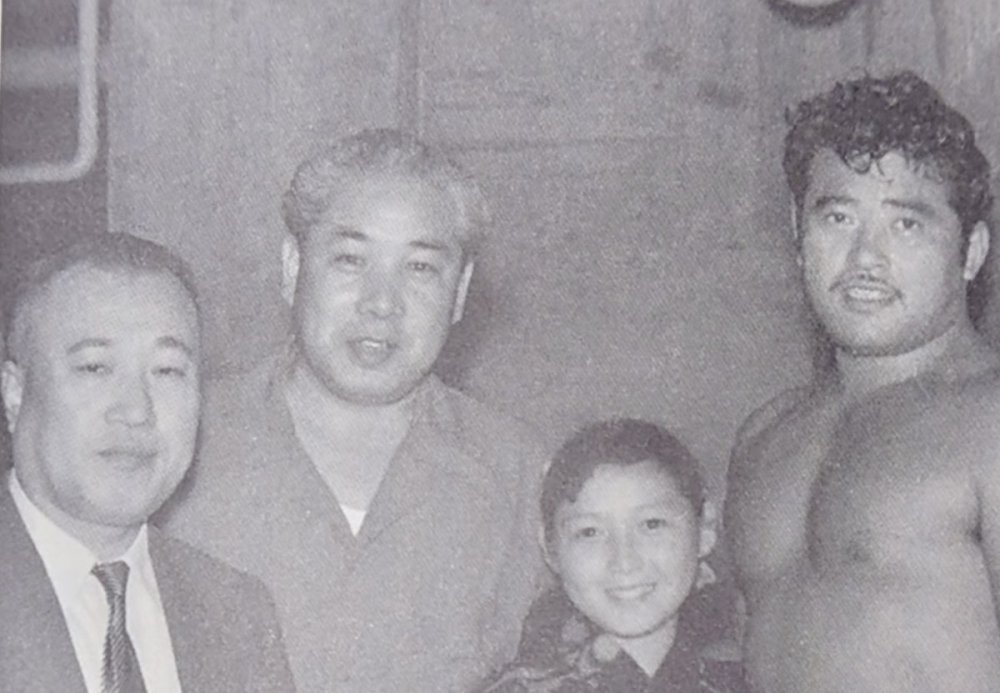
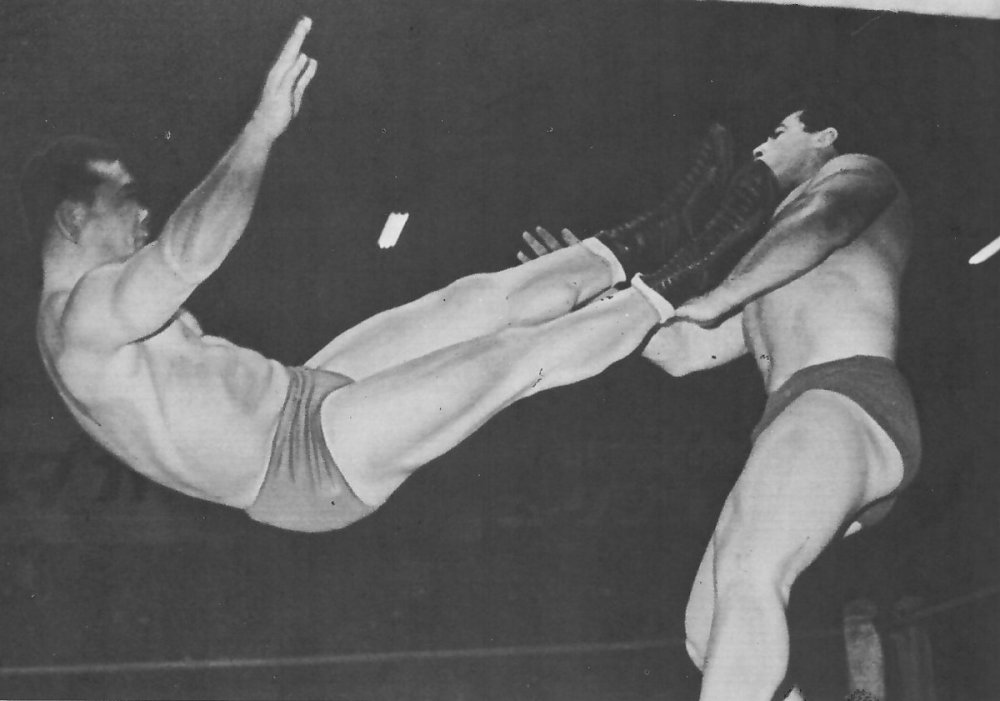
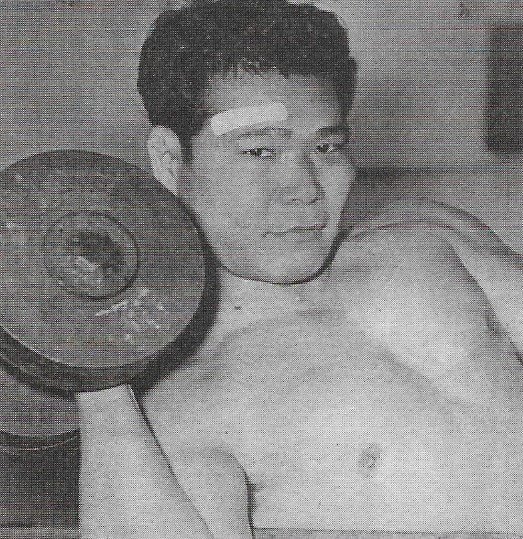
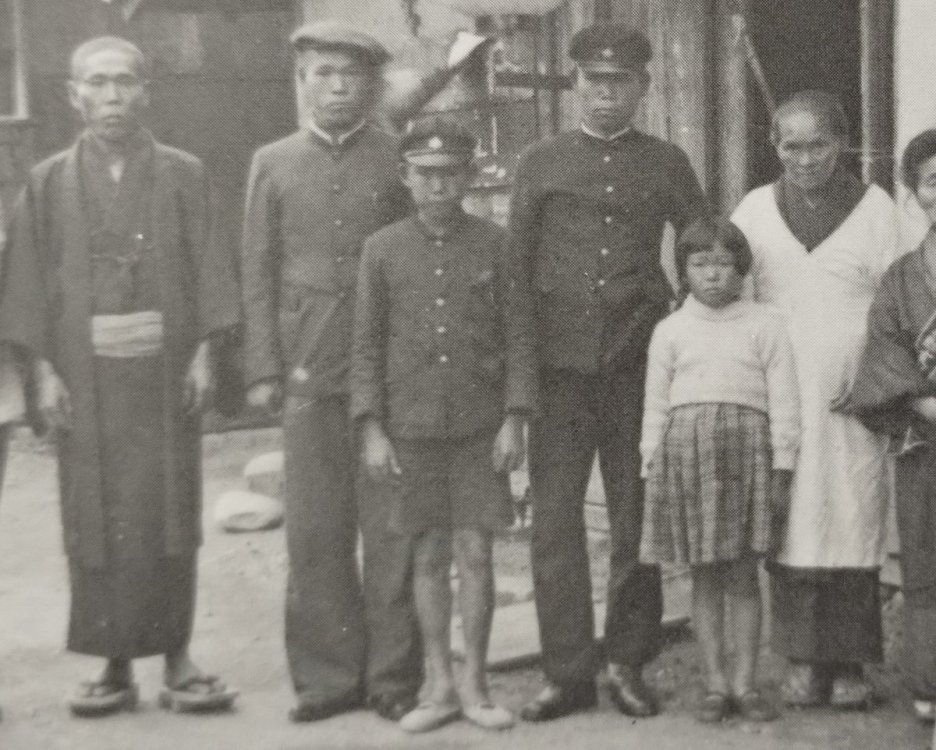
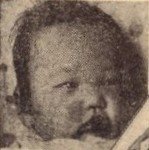
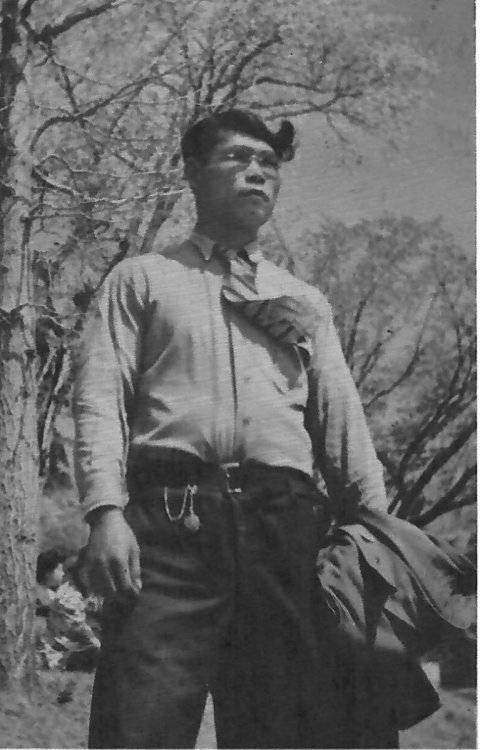
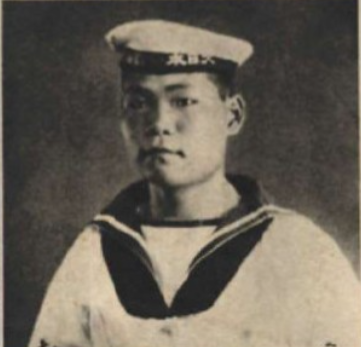
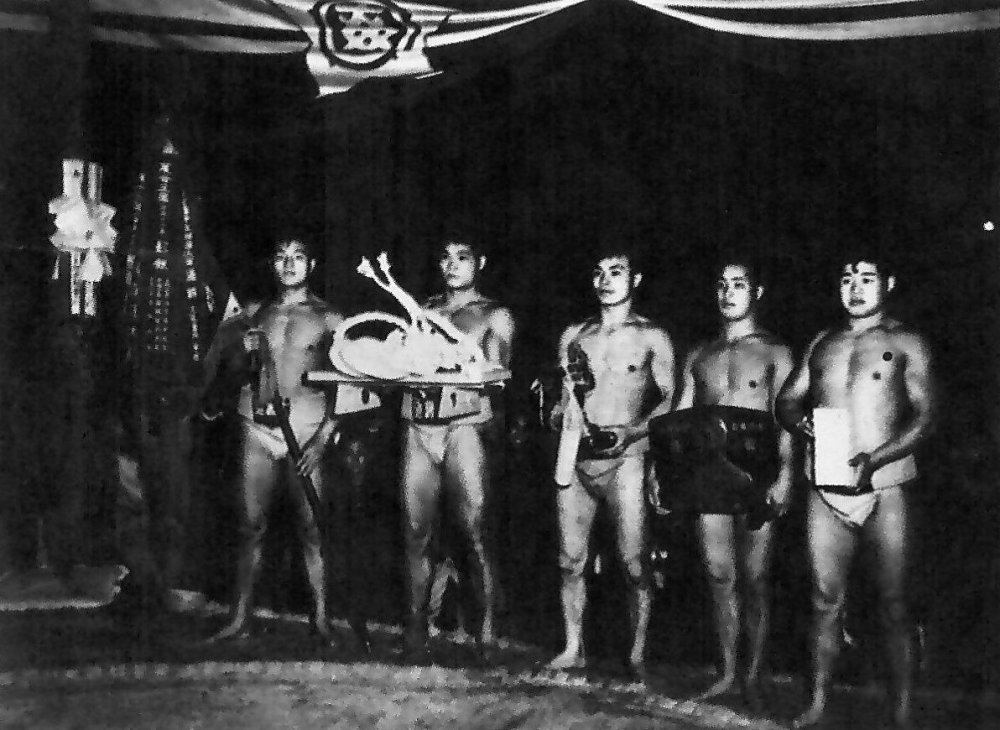
.thumb.jpg.6e5725a57f57be64a927ffeff2ab8186.jpg)
.thumb.jpg.9d5abfb60f6db76d67014ad9ac0d60f9.jpg)
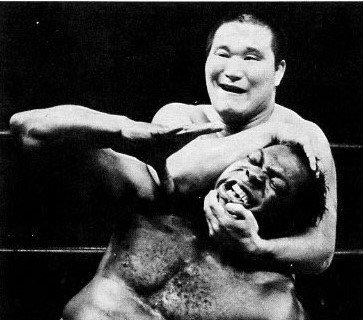
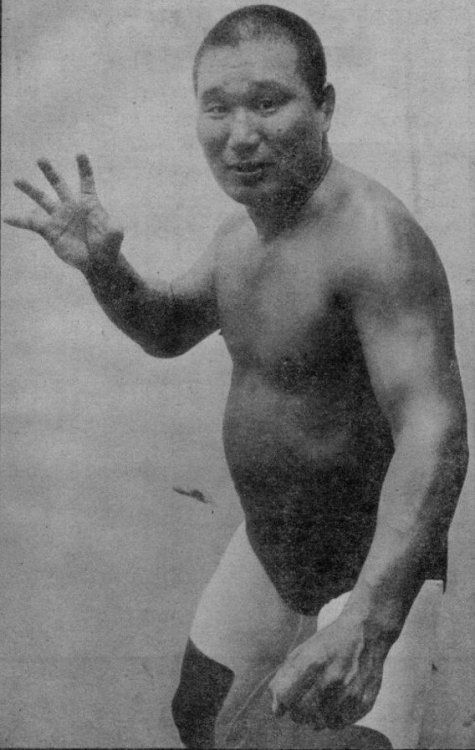
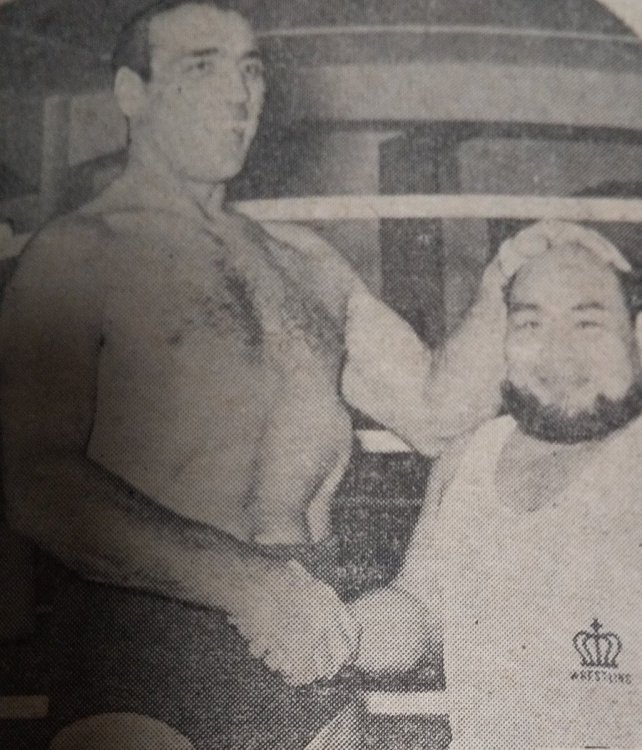
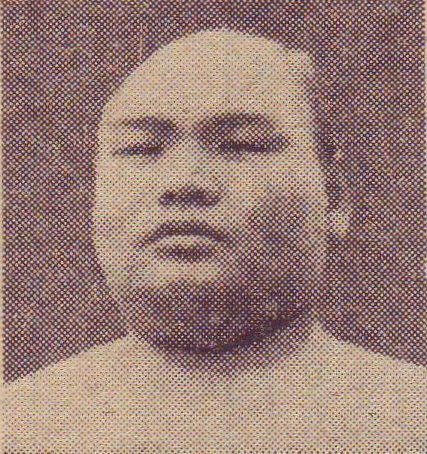
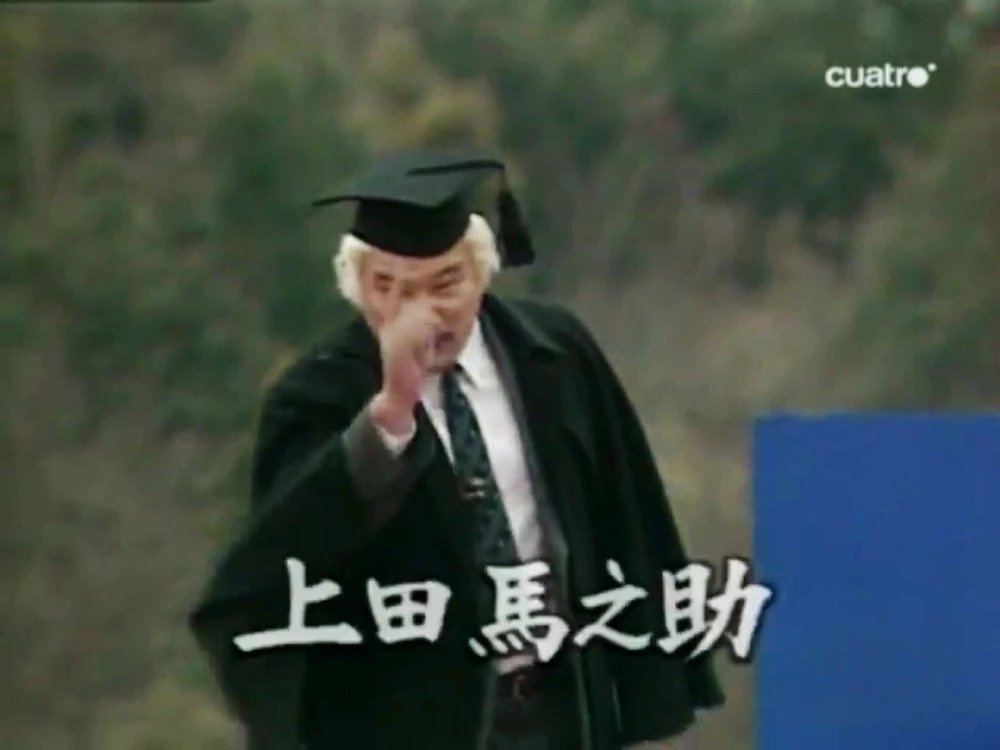
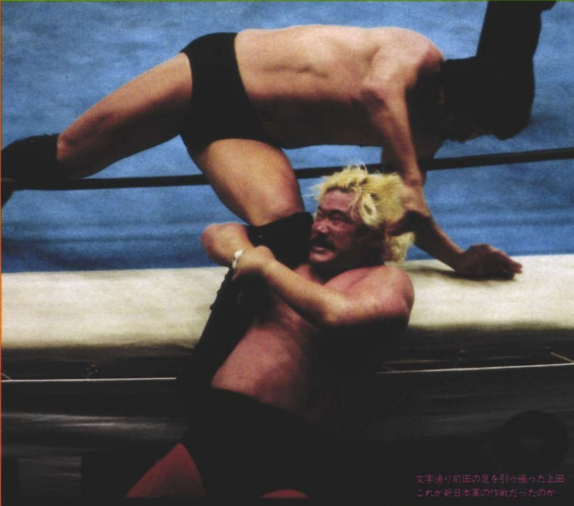
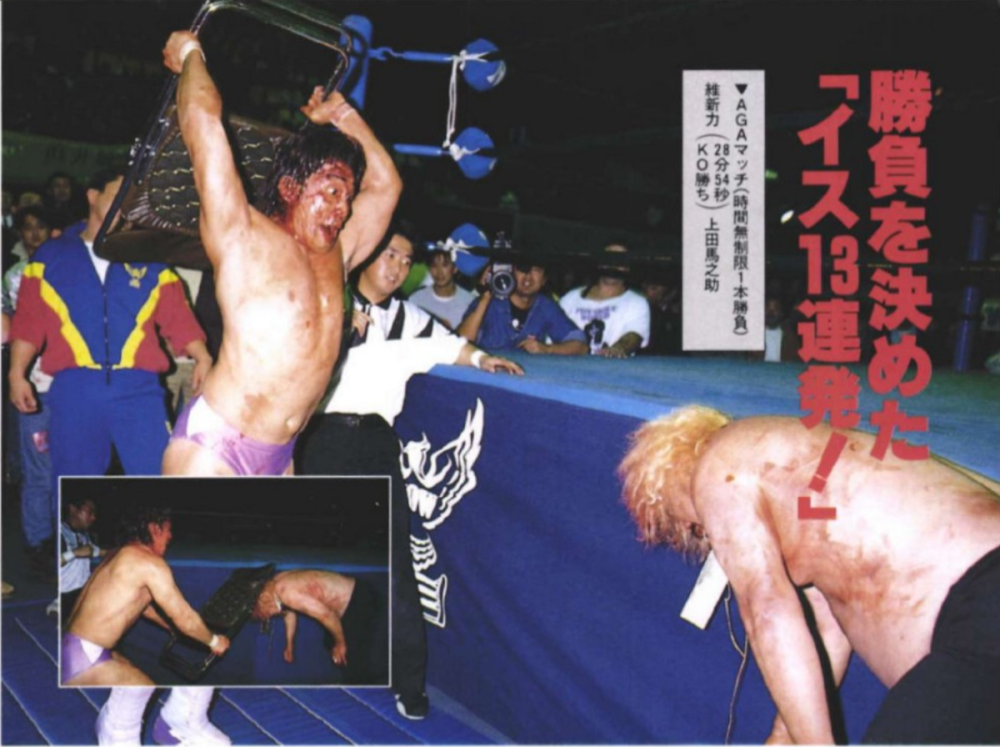
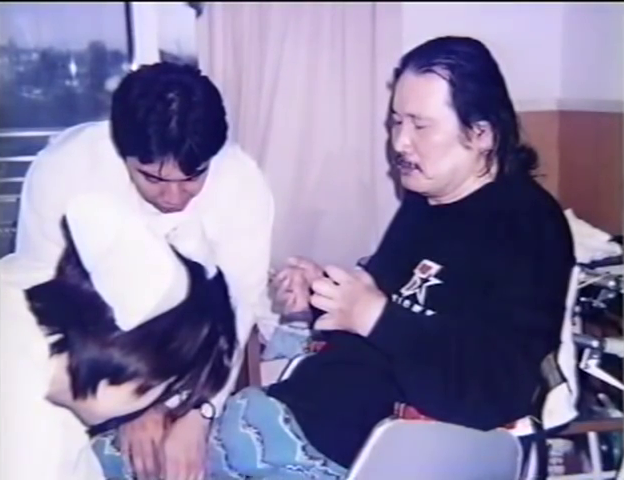
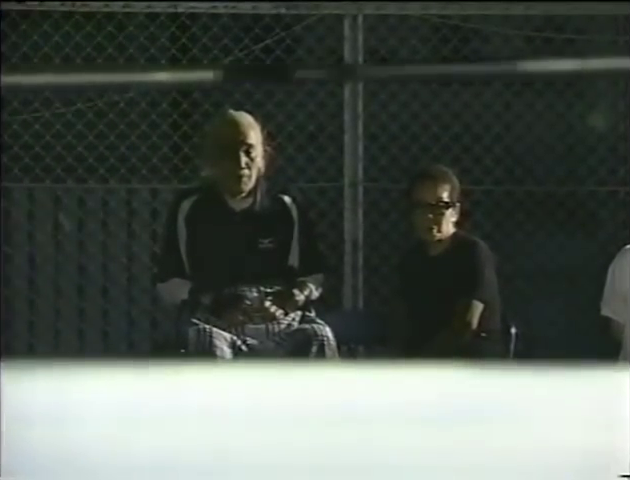
.jpg.3822bca6bcbf89f623a8781e7ff1895c.jpg)
